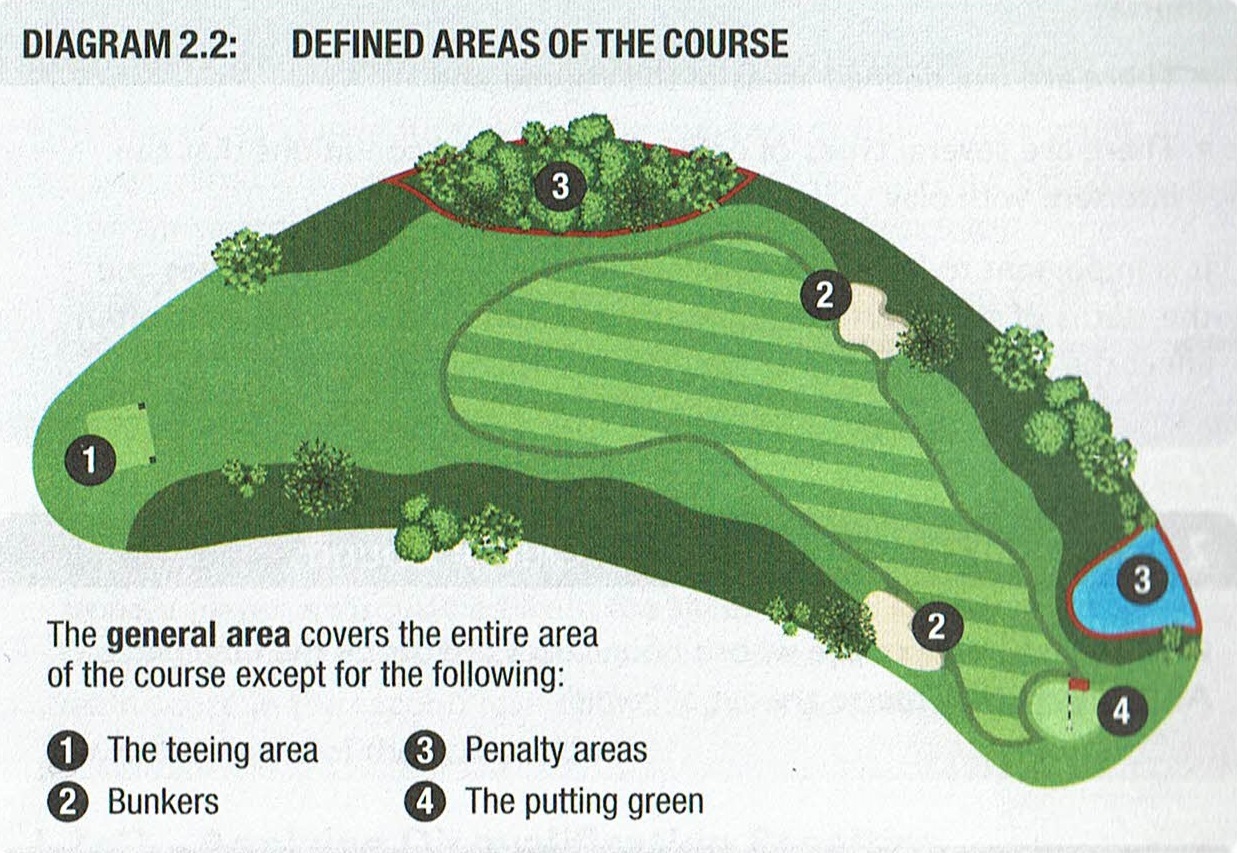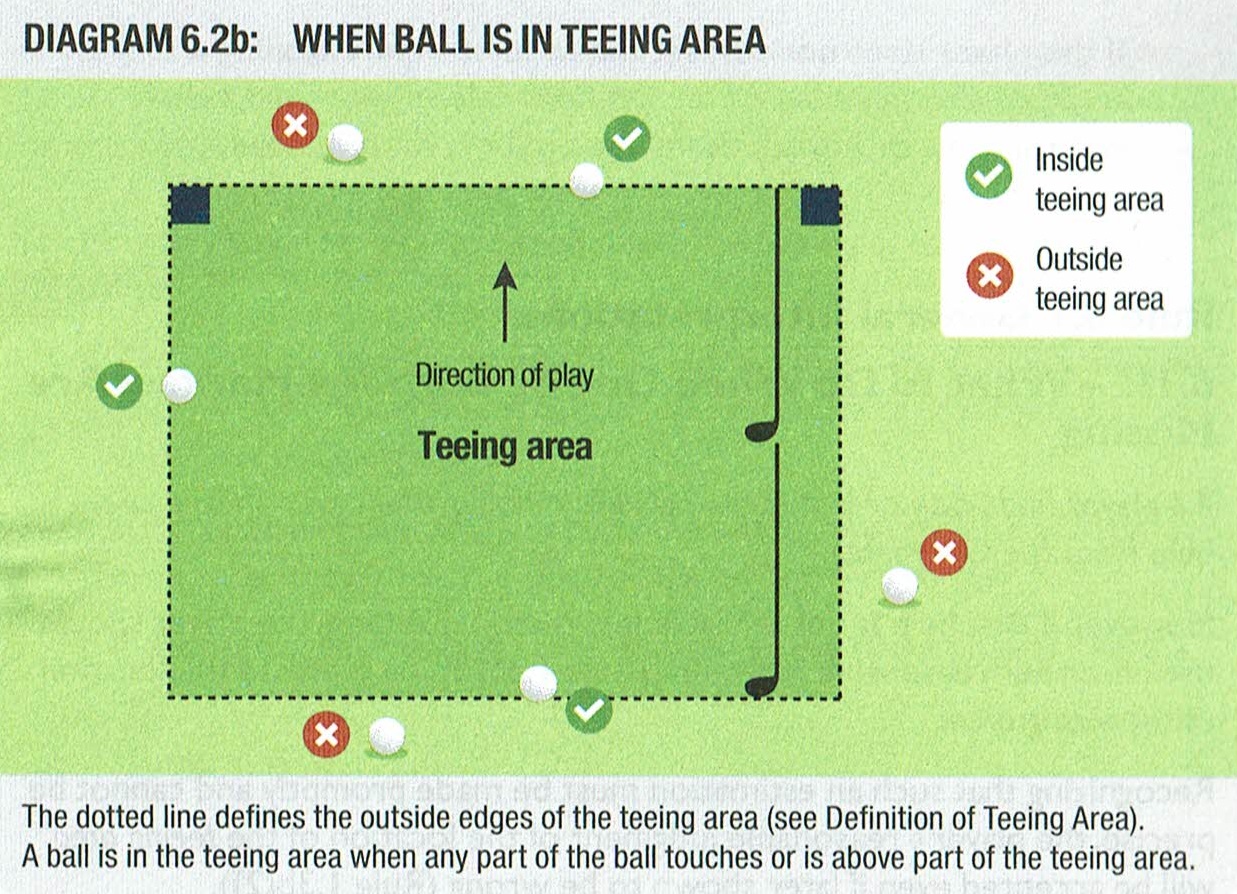V
- LIFTING and RETURNING a BALL to PLAY (RULE 14)
Rule 14
– Procedures for Ball: Marking, Lifting and Cleaning;
Replacing on Spot;
Dropping in Relief Area; Playing from Wrong Place
Rule
14 covers when and how the
player may mark the spot of a ball at
rest and lift and clean the ball and how to put a ball back into play
so that the ball is played from the right place.
•
When a lifted
or moved ball is to be replaced, the same ball must be set down on its
original spot.
•
When taking free relief (Rule 15) or penalty relief (Rule 16), a
substituted ball or the
original ball must be dropped in a particular relief area.
A
mistake in using these procedures may be corrected without penalty
before the ball is played, but the player gets a penalty if he or she
plays the ball from the wrong place.
14.1 Marking, Lifting and
Cleaning Ball
This
Rule applies to the deliberate “lifting” of a
player’s ball at rest, which includes picking up the ball by
hand, rotating it or otherwise deliberately causing it to move from its
spot.
a. Spot of Ball to Be
Lifted and Replaced Must Be Marked before lifting by
doing one of the following:
•
Place a ball-marker right behind or right next to the ball, or
•
Hold a club on the ground right behind or right next to the ball.
If
the spot is marked with a ball-marker, after replacing the ball the player must remove the
ball-marker before making a stroke.
If
the player lifts the ball without marking its spot, marks its spot in a
wrong way or makes a stroke with a ball-marker left in place, the
player gets one
penalty stroke.
c. Cleaning Lifted Ball
A ball lifted from the
putting green may always be cleaned (see Rule 13.1b).
A
ball lifted from anywhere else
may always be cleaned except when it is lifted:
•
To See If It Is Cut or Cracked. Cleaning is not allowed (see Rule
4.2c(1)).
• To Identify It. Cleaning is allowed only as needed
to identify it (see Rule 7.3).
• Because It Interferes with Play. Cleaning is not
allowed (see Rule 15.3b(2)).
• To See If It Lies in Condition Where Relief Is
Allowed. Cleaning is not allowed, unless the player then takes relief
under a Rule (see Rule 16.4).
If
the player cleans a lifted ball when not allowed, he gets one
penalty stroke.
14.2
Replacing Ball on
Spot
This Rule applies
whenever a ball is lifted or moved and a Rule requires it to be
replaced on a spot.
a. Original Ball Must Be
Used when replacing a
ball>
Exception
– Another Ball May Be Used When:
•
The
original ball cannot be recovered with reasonable effort and in a few
seconds, so long as the player did not deliberately cause the ball to
become unrecoverable,
•
The original ball is cut or cracked (see Rule 4.2c),
•
Play resumes after it had been stopped (see Rule 5.7d), or
•
The original ball was played by another player as a wrong ball (see
Rule 6.3c(2)).
b. Who
Must Replace Ball and How It Must Be Replaced
(1) Who May
Replace Ball: The
player’s ball must be replaced under the
Rules only by:
•
The player, or
•
Any person who lifted the ball or caused it to move (even if that
person was not allowed to do so under the Rules).
If
the player plays a ball that was replaced by someone not allowed to do
so, the player gets one penalty
stroke.
(2)
How Ball Must Be Replaced.
The ball must be replaced by setting
it down
on the required spot and letting it go so that it stays on that spot.
If
the player plays a ball that was replaced in a wrong way but on the
required spot, the player gets one
penalty stroke.
c. Spot Where Ball Is
Replaced
The
ball must be replaced on its original spot (which if not known must
be
estimated), except when the
ball must be replaced on a different
spot
under Rules 14.2d(2) and 14.2e. If the ball was at rest on, under or
against any immovable obstruction, integral object, boundary object or
growing or attached natural object:
•
The “spot” of the ball includes its vertical
location relative to the ground.
•
This means that the ball must be replaced on its original spot on,
under or against such object.
If
any loose impediments were removed as a result of the ball being lifted
or moved or before the ball was replaced, they do not need to be
replaced.
For
restrictions on removing loose impediments before replacing a lifted or
moved ball see Rule 15.1a, Exception 1.
d.
Where to
Replace Ball When Original Lie Altered
If the lie of a lifted or moved ball that must be replaced is altered,
the player must replace the ball in this way:
(1)
Ball in Sand. When the ball
was in sand, whether in a bunker or
anywhere else on the course:
•
In replacing the ball on its original spot (which if not known must be
estimated) (see Rule 14.2c), the player must re-create the original lie
as much as possible.
•
In re-creating the lie, the player may leave a small part of the ball
visible if the ball had been covered by sand.
If
the player fails to re-create the lie in breach of this Rule, the
player has played from a wrong place - General Penalty.
(2) Ball Anywhere Except in Sand.
When the ball was anywhere
except in
sand, the player must replace the ball by placing it on the nearest
spot with a lie most similar to the original lie that is:
•
Within one club-length from its original spot
(which if not known must be estimated) (see Rule 14.2c),
•
Not nearer the hole, and
•
In the same area of the
course as that spot.
If the player knows that the original lie was altered but
does not know what the lie was, the player must estimate the original
lie and replace the ball under (1) or (2).
Exception – For Lies Altered While Play is Stopped
and Ball Has Been Lifted, see Rule 5.7d.
e. What to Do If
Replaced Ball Does
Not Stay on Original Spot
If
the player tries to replace a ball
but it does not stay on
its original spot, the player must try a second time.
If the ball again does not stay on that spot, the player must
replace the ball by placing it on the nearest spot where the ball will
stay at rest, but with these limits depending on where the original
spot is located:
•
The spot must not be nearer the hole.
•
Original Spot in General
Area. The nearest spot
must be in the general area.
•
Original Spot in Bunker
or Penalty Area. The
nearest spot must be either in the same bunker or in the same penalty
area.
•
Original Spot on Putting
Green. The nearest spot
must be either on the putting green or in the general area.
Penalty for Playing Incorrectly Substituted Ball or Playing
Ball from a Wrong Place in Breach of Rule 14.2:
General Penalty under
Rule 6.3b or 14.7a.
14.3 Dropping Ball in
Relief Area
This
Rule applies whenever a player must drop a ball in taking relief under
a Rule, including when the player must complete taking relief by
placing a ball under Rule 14.3c(2).
If the player
improves the relief
area before or when dropping a ball, see Rules 8 and 15.1 for
clarification.
a.
Original Ball or Another Ball May Be Used
b.
Ball Must Be Dropped in Right Way The player must
drop a ball in the
right way, which means all three of these things:
(1)
Player Must Drop
Ball. The ball must be
dropped only by the player. Neither the
player’s caddie nor anyone else may do so.
(2)
Ball Must Be
Dropped Straight Down from Knee Height Without Touching Player or
Equipment. The
player
must let go of the ball from a location at knee height so that the
ball:
•
Falls straight down, without the player throwing, spinning or rolling
it or using any other motion that might affect where the ball will come
to rest, and
•
Does not touch any part
of the player’s body or equipment before it hits the ground.
“Knee
height”
means the height of the player’s knee when in a standing
position.
(3)
Ball Must Be
Dropped in Relief Area.
The player may stand either inside or outside the relief area when
dropping the ball.
If
a ball is dropped in a wrong way in breach of one or more of these
three requirements:
•
The
player must drop a ball again in the right way, and there is no limit
to the number of times the player must do so.
•
A
ball dropped in the wrong way does not count as one of the two drops
required before a ball must be placed under Rule 14.3c(2).
If
the player does not drop
again and instead makes a stroke at the ball from where it came to rest
after being dropped in a wrong way:
• If the ball
was played from the
relief area, the player gets one
penalty stroke (but has not
played from a wrong place under Rule
14.7a).
•
But
if the ball was played from outside the relief area, or after it was
placed when required to be dropped (no matter where it was played
from), the player gets the general
penalty.
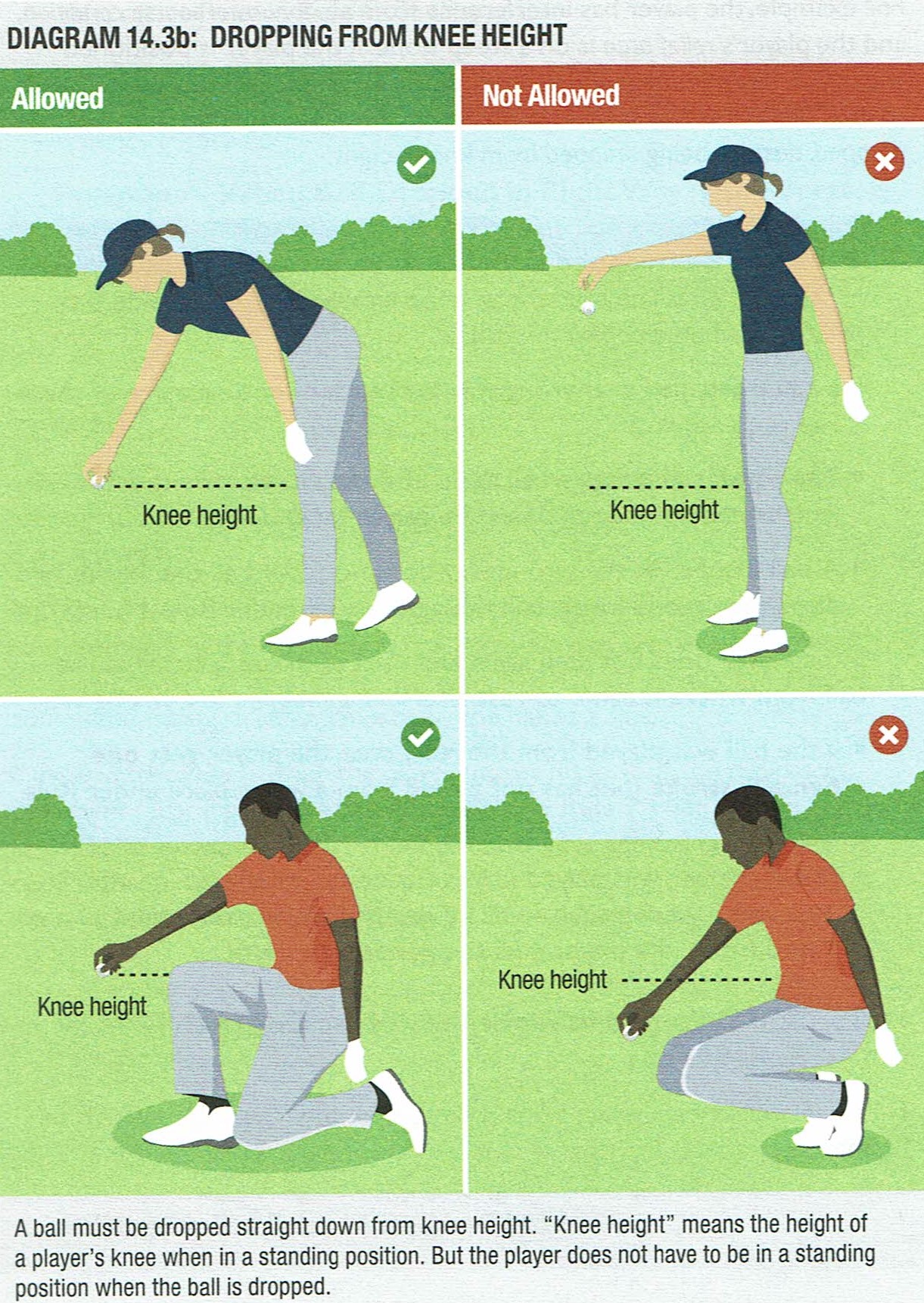
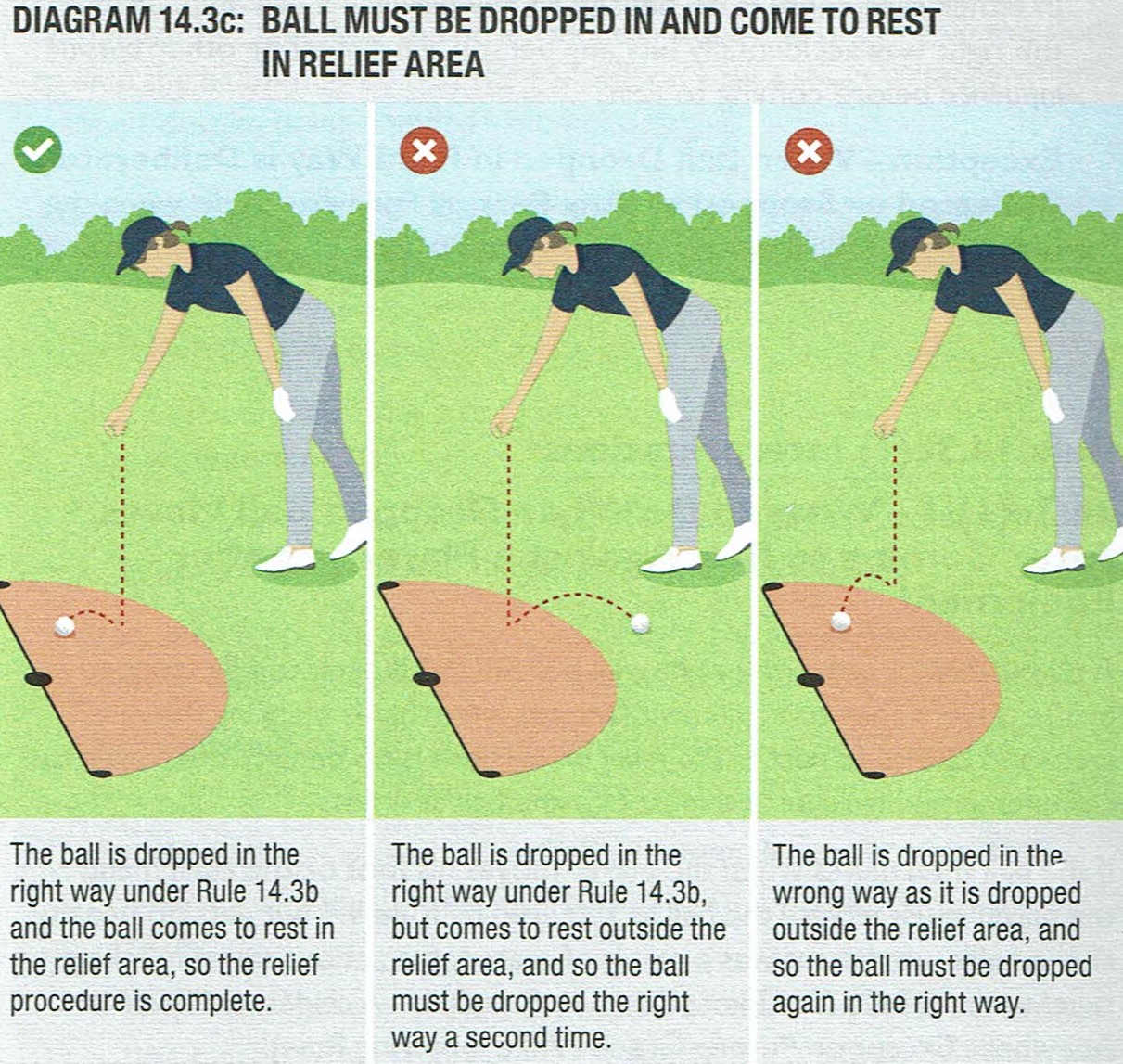
c. Ball Dropped in Right Way Must Come to Rest in Relief Area
This Rule
applies only when a ball
is dropped in the right way under Rule 14.3b.
(1) Player Has Completed
Taking Relief When
Ball Dropped in Right Way Comes to Rest in Relief Area.
The ball
must come to rest in the relief area.
It
does not matter whether the ball, after hitting the ground, touches any
person, equipment or other outside influence before coming to rest:
•
If the ball
comes to rest in the relief area, the player has completed taking
relief and must play the ball as it lies.
•
If the
ball comes to rest outside the relief area, the player must use the
procedures in Rule 14.3c(2).
In
either case, there is no penalty to any player if a ball dropped in the
right way accidentally hits any person, equipment or other outside
influence before coming to rest.
Exception
– When Ball Dropped
in Right Way is Deliberately Deflected or Stopped by Any Person, see
Rule 14.3d.
(2)
What to Do if Ball Dropped in Right Way Comes to Rest Outside Relief
Area.
If the ball comes to rest
outside the
relief area, the player must
drop a ball in the right way a
second time.
If
the second dropped ball also comes
to rest outside the relief area, the player must complete
taking
relief by placing a ball using the procedures for replacing a ball in
Rules 14.2.
•
The
player must place a ball on the spot where the ball dropped the second
time first touched the ground.
•
If
the placed ball does not stay at rest on that spot, the player must
place a ball on that spot a second time.
•
If
the ball placed a second time also does not stay on that spot, the
player must place a ball on the nearest spot where the ball will stay
at rest, subject to the limits in Rule 14.2e.
d.
What to Do if Ball Dropped in Right Way is Deliberately Deflected or
Stopped by Person
When
a ball dropped in the right way is deliberately deflected or stopped by
any person (whether in the relief area or outside the relief area)
before it comes to rest:
•
The player must drop a ball again, using the procedures in Rule 14.3b
(which means that the ball that was deliberately deflected or stopped
does not count as one of the two drops required before a ball must be
placed under Rule 14.3c(2)).
•
If the ball was deliberately deflected or stopped by any player or his
or her caddie, that player gets the general penalty.
Exception
– When There Is No Reasonable Chance Ball Will Come to Rest
in
Relief Area:
•
There is no penalty to any
player, and
•
The dropped ball is treated as
having come to rest outside the relief area and counts as one of the
two drops required before a ball must be placed under Rule 14.3c(2).
Penalty for Playing Ball from a Wrong Place or Playing Ball that was
Placed Instead of Dropped in Breach of Rule 14.3: General Penalty
under Rule
14.7a.
14.4
When your Ball is
Back in Play
When
a player’s ball in play is lifted from the course or is lost
or
out of bounds, the ball is no longer in play. The player has a ball in
play again only
when he or she:
•
Plays the
original ball or another ball from the teeing area, or
•
Replaces,
drops or places the original ball or another ball on the course with
the intent for that ball to be in play. If the
player
returns a ball to the course in any way with the intent for it to be in
play, the ball is in play even if it was:
•
Substituted for
the original ball when not allowed under the Rules, or
•
Replaced,
dropped or placed (1) in a wrong place, (2) in a wrong way or (3) by
using a procedure that did not apply. A replaced
ball is in
play even if the ball-marker marking its spot has not been removed.
14.5
Correcting
Mistake Made in Substituting, Replacing, Dropping or Placing Ball
a. Player May Lift Ball to
Correct Mistake
Before Ball Is Played
- When
a player
has substituted another ball
for the original ball when not allowed under the Rules,
- or
the
player’s ball in play was replaced, dropped, or placed (1) in a wrong place
or came
to rest in a wrong place, (2)
in a wrong way
or (3)
by using a procedure that did not apply:
•
The player may lift the ball without penalty and correct the mistake.
•
But this is allowed only
before the ball is played.
b.
When Player May
Change to a Different Rule or Relief Option When Correcting Mistake in
Taking Relief
When
correcting a
mistake in taking relief, whether the player must use the same Rule and
relief option originally used, or may change to a different Rule or
relief option, depends on the nature of the mistake:
(1)
When Ball Was
Put in Play under Rule That Did Not Apply.
•
In correcting
this mistake, the player may use any Rule that applies to his or her
situation.
•
For example, if the player
mistakenly took unplayable ball relief for his or her ball in a penalty
area (which Rule 19.1 does not allow), the player must correct the
mistake by either replacing the ball (if it had been lifted) under Rule
9.4, or taking penalty relief under Rule 17 and may use any relief
option under that Rule that applies to his or her situation.
(2)
When Ball Was Put in Play under Rule That Applied but Ball Was Dropped
or Placed in Wrong Place.
•
In correcting
this mistake, the player must go on to take relief under the same Rule
but may use any relief option under that Rule that applies to his or
her situation.
•
For example, if when taking
relief for an unplayable ball, the player used the lateral relief
option Rule (19.2c) and mistakenly dropped the ball outside the
required relief area, in correcting the mistake the player must go on
to take relief under Rule 19.2 but may use any of the relief options in
Rule 19.2a, b or c.
(3)
When Ball Was Put in Play under Rule That Applied and Was Dropped or
Placed in Right Place, but Rule Requires Ball to Be Dropped or Placed
Again.
•
In correcting
this mistake, the player must go on to take relief using the same Rule
and the same relief option under that Rule.
•
For example, if when taking
relief for an unplayable ball, the player used the lateral relief
option (Rule 19.2c) and the ball was (1) dropped in the right relief
area but (2) was dropped in a wrong way (see Rule 14.3b) or came to
rest outside the relief area (see Rule 14.3c), in correcting the
mistake the player must go on to take relief under Rule 19.2 and must
use the same relief option (lateral relief under Rule 19.2c).
c.
No
Penalties for Ball Lifted to Correct Mistake When a ball is lifted
under Rule 14.5a to
correct a mistake:
•
The player does
not count any penalty for actions that were taken relating to that ball
after the mistake and before it was lifted, such as for accidentally
causing it to move (see Rule 9.4b).
•
But if
those same actions were also in breach of a Rule relating to the ball
that was put in play to correct the mistake (such as when those actions
improved the conditions affecting the stroke for both the ball now in
play and the original ball before it was lifted), the penalty applies
to the ball now in play.
14.6
Making Next
Stroke from Where Previous Stroke Made
This
Rule applies
whenever a player is required or allowed under the Rules to make the
next stroke from where a previous stroke was made (that is, when taking
stroke-and-distance relief, or playing again after a stroke that is
canceled or otherwise does not count).
•
How the player must put a ball in play depends on the area of the
course where that previous stroke was made.
•
In all of these
situations, the player may use either the original ball or another
ball.
a. Previous Stroke Made
from Teeing Area
The
original ball or another ball must be played from anywhere inside the
teeing area (and may be teed) under Rule 6.2b.
b.
Previous Stroke Made from General Area, Penalty Area or Bunker
The
original ball or another ball must be dropped in this relief area (see
Rule 14.3):
•
Reference
Point: The spot where the previous stroke was made (which if not known
must be estimated).
•
Size
of Relief Area Measured from Reference Point: One club-length, but with
these limits:
•
Limits on Location of Relief
Area:
•
Must be in the same area of the course as the reference point,
and
•
Must not be nearer the hole
than the reference point.
c.
Previous Stroke Made from Putting Green
The
original ball or another ball must be placed on the spot where the
previous stroke was made (which if not known must be estimated) (see
Rule 14.2), using the procedures for replacing a ball under Rules
14.2b(2) and 14.2e.
Penalty
for Playing Ball from a
Wrong Place in Breach of Rule 14.6: General Penalty
Under Rule
14.7a.
14.7 Playing
from Wrong Place
a.
Place from
Where Ball Must Be Played
After
starting a hole:
•
A player must
make each stroke from where his or her ball comes to rest, except when
the Rules require or allow the player to play a ball from another place
(see Rule 9.1).
•
A player
must not play his or her ball in play from a wrong place.
Penalty
for Playing Ball from a
Wrong Place in Breach of Rule 14.7a: General Penalty.
b.
How to Complete a Hole after
Playing from Wrong Place in Stroke Play
(1) Player Must Decide
Whether to Play Out
Hole with Ball Played from Wrong Place
by either:
•
Correcting the mistake and playing out the hole while taking
the General
Penalty.
•
Picking up and taking the
Local Tour Rule Triple Bogey Max for the hole.
VI
- FREE RELIEF (RULES 15 & 16)
Rule
15
– Relief from Loose Impediments and Movable
Obstructions
(including Ball or Ball-Marker Helping or Interfering with
Play)
•
These movable
natural and artificial objects are not treated as part of the challenge
of playing the course, and a player is normally allowed to remove them
when they interfere with play.
•
But the
player needs to be careful in moving loose impediments near his or her
ball off the putting green, because there will be a penalty if moving
them causes the ball to move.
15.1 Loose
Impediments
a. Removal of Loose
Impediment
Without penalty, a player
may remove a
loose impediment anywhere on or off the course, and may do so in any
way (such as by using a hand or foot or a club or other
equipment). This includes a relief area where a ball is to be dropped,
or placed, but not replaced (see Exception 1).
But
there are two exceptions:
Exception
1
– Removing Loose Impediment Where Ball Must Be Replaced:
Before
replacing a ball that was lifted or moved from anywhere except the
putting green:
•
A
player must not deliberately remove a
loose impediment that, if
moved when the ball was at rest, would
have been
likely to have caused the
ball to move.
•
If
the player does so, he or she gets one
penalty stroke, but the
removed loose impediment does not need
to be replaced.
Exception 2
– Restrictions on Deliberately Removing Loose Impediments to
Affect Ball in Motion (see Rule 11.3).
b. Ball Moved
When Removing Loose
Impediment: If a
player’s removal of a loose impediment causes his or her ball
to
move:
•
The ball must be replaced on its original spot (which if not known must
be estimated) (see Rule 14.2).
• If the moved
ball had been at rest
anywhere except on the putting green (see Rule 13.1d) or in the teeing
area (see Rule 6.2b(6)), the player gets one penalty stroke under Rule 9.4b, except
when Rule 7.4
applies (no
penalty for ball moved
during search) or when
another exception to Rule 9.4b applies.
Penalty
for Playing Incorrectly Substituted Ball or Playing Ball from a Wrong
Place in Breach of Rule 15.1: General
Penalty Under Rule 6.3b or
14.7a.
15.2
Movable
Obstructions
This
Rule covers
free relief that is allowed from artificial objects that meet the
definition of movable obstruction.
It
does not give relief from immovable obstructions (a different type of
free relief is allowed under Rule 16.1), or boundary objects, or
integral objects (no free relief is allowed).
a. Relief from Movable
Obstruction
(1) Removal of Movable
Obstruction.
Without penalty, a player may remove a movable obstruction anywhere on
or off the course and may do so in any way.
But
there are two exceptions:
Exception
1
– Tee Markers Must Not be Moved When Ball Will Be Played from
Teeing Area (see Rules 6.2b(4) and 8.1a(1)).
Exception
2
– Restrictions on Deliberately Removing Movable Obstruction
to
Affect a Ball in Motion (see Rule 11.3).
If
a player’s ball moves
while he or she is removing a movable obstruction:
•
There is no penalty, and
•
The ball must be
replaced on its original spot (which if not known must be estimated)
(see Rule 14.2).
(2)
Relief When Ball Is in or on Movable Obstruction Anywhere on Course
Except on Putting Green. The
player may take free relief by
lifting the ball, removing the movable obstruction and dropping the
original ball, or another ball in this relief area (see Rule 14.3):
•
Reference
Point: The estimated point right under where the ball was at rest in or
on the movable obstruction.
•
Size
of Relief Area Measured from Reference Point: One club-length, but with
these limits:
•
In the same area of the course as the reference point and not nearer
the hole.
(3)
Relief When Ball Is in or on Movable Obstruction on Putting Green. The
player may take free relief by:
•
Lifting the ball and
removing the movable obstruction, and •
Placing the
original ball or another ball on the estimated spot right under where
the ball was at rest in or on the movable obstruction, using the
procedures for replacing a ball under Rule 14.2b(2) and 14.2e.
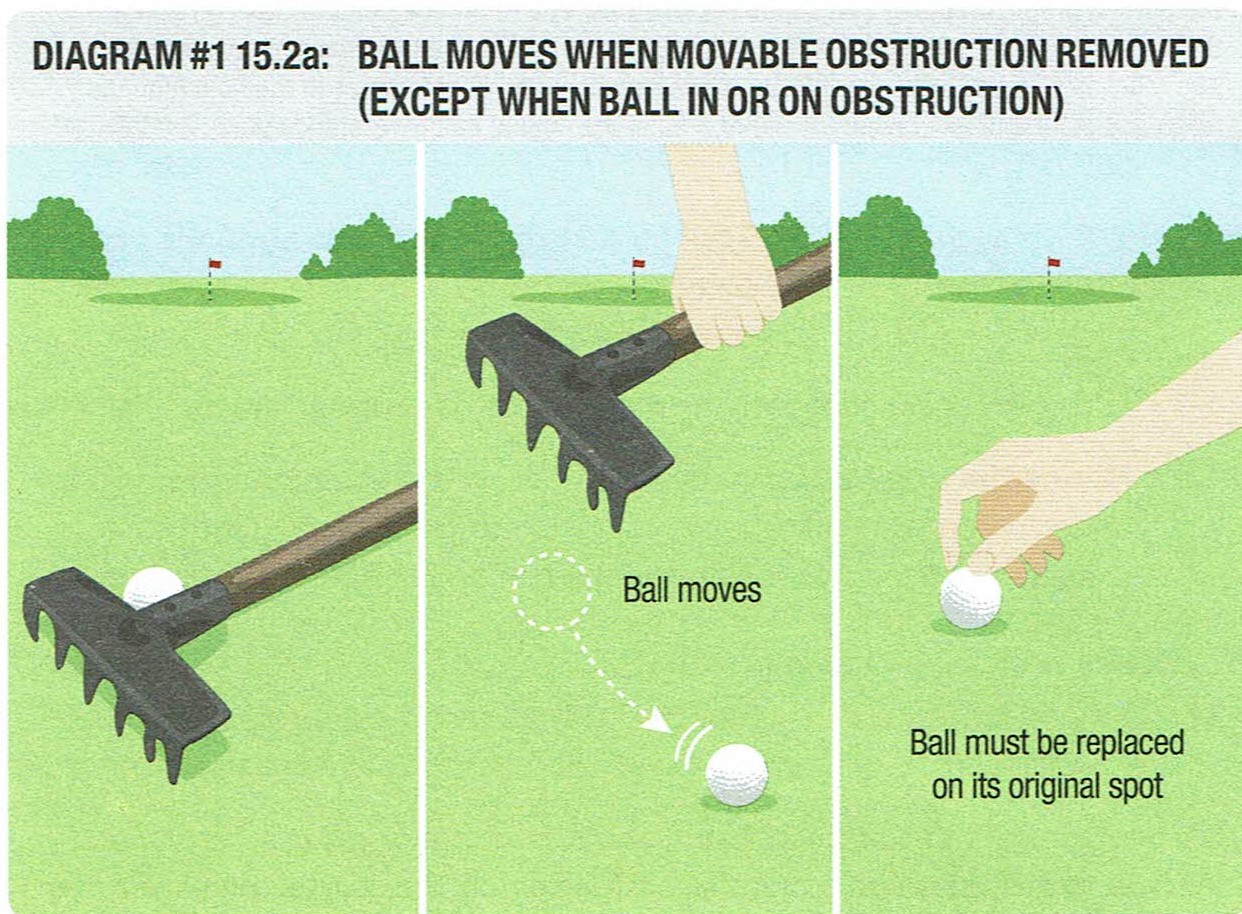
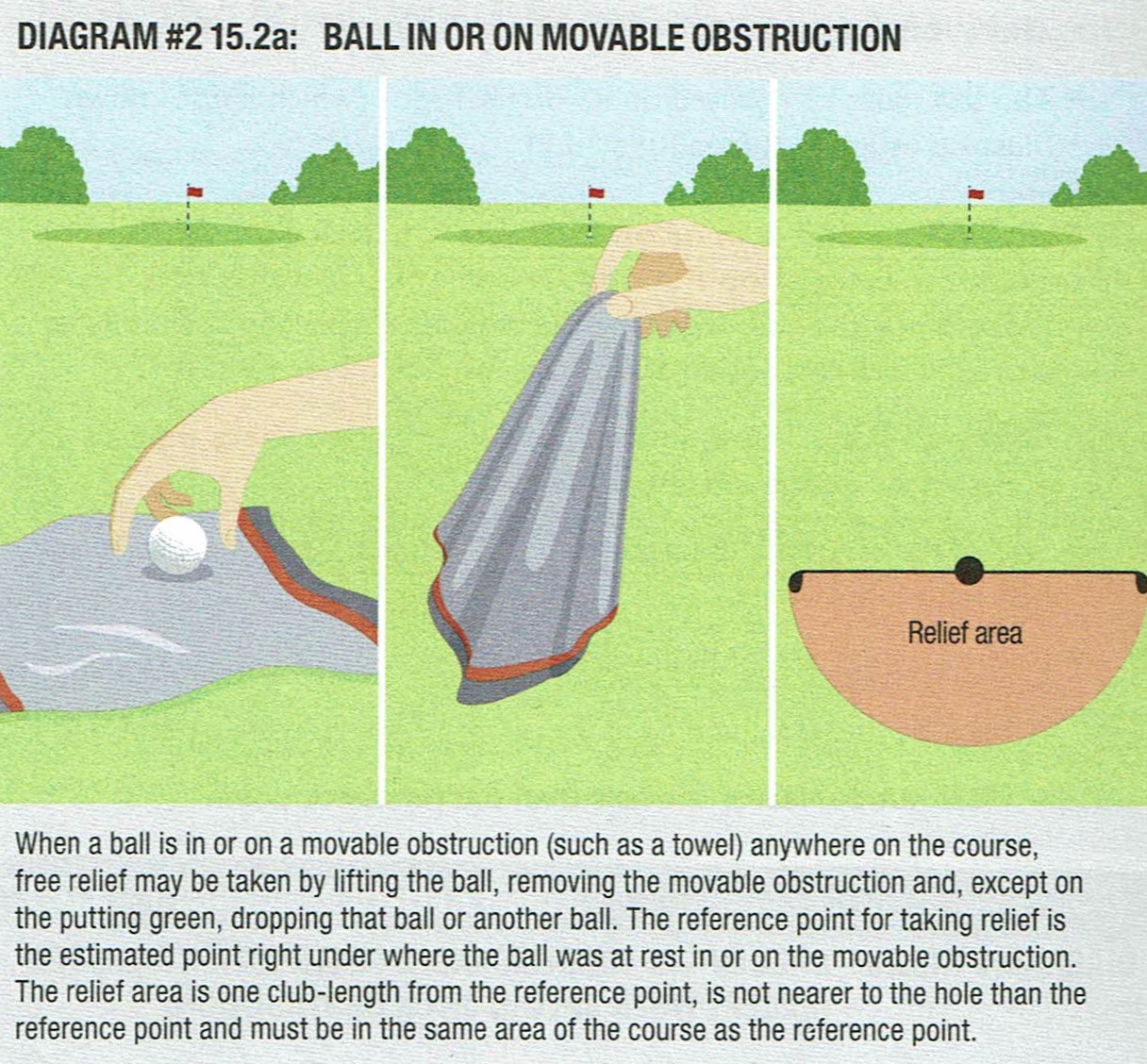
b. Relief for Ball Not
Found but In or On
Movable Obstruction
If a
player’s ball has not been found, and it is known or
virtually
certain that it came to rest in or on a movable obstruction on the
course, the player may use this relief option instead of taking
stroke-and-distance relief:
• The player may
take free relief
under Rule 15.2a(2) or 15.2a(3), using the estimated point right under
where the ball last crossed the edge of the movable obstruction on the
course as the reference point.
•
Once the player
puts another ball in play to take relief in this way:
•
The original ball is no longer in play and must not be played.
•
This is true even if it is
then found on the course before the end of the three minute search time
(see Rule 6.3b).
But if
it is not known
or virtually certain that the
ball came to rest in or on a movable obstruction and the ball is lost,
the player must take stroke-and-distance relief under Rule 18.2.
Penalty
for Playing Incorrectly
Substituted Ball or Playing Ball from a Wrong Place in Breach of Rule
15.2: General
Penalty
Under Rule 6.3b or 14.7a.
15.3 Ball or
Ball-Marker Helping or
Interfering with Play
a. Ball on Putting Green
Helping Play Rule
15.3a applies only
to a ball at rest
on the putting green, not anywhere else on the course.
If a
player reasonably believes that a ball on the putting green might help
anyone’s play (such as by serving as a possible backstop near
the
hole), the player may:
•
Mark the spot
of the ball and lift it under Rule 13.1b if it is his or her own ball,
or if the ball belongs to another player, require the other player to
mark the spot and lift the ball (see Rule 14.1).
•
The lifted
ball must be replaced on its original spot (see Rule 14.2).
•
A player who is
required to lift a ball may play first instead, and
•
If two or
more players agree to leave a ball in place to help any player, and
that player then makes a stroke with the helping ball left in place,
each player who made the agreement gets the general penalty (two penalty strokes).
b.
Ball
Anywhere on Course Interfering with Play
(1) Meaning of
Interference by Another
Player’s Ball.
Interference under this Rule exists when
another player’s ball at rest:
•
Might interfere
with the player’s area of intended stance or area of intended
swing,
•
Is on or
close to the player’s line of play such that, given the
intended
stroke, there is a reasonable chance the player’s ball in
motion
could hit that ball, or
•
Is close
enough to distract the player in making the stroke.
(2)
When Relief Is Allowed from Interfering Ball.
If a player
reasonably believes that another player’s ball anywhere on
the
course might interfere with the player’s own play:
•
The player may
require the other player to mark the spot and lift the ball (see Rule
14.1), and the ball must not be cleaned (except when lifted from the
putting green under Rule 13.1b) and must be replaced on its original
spot (see Rule 14.2).
•
If the
other player does not mark the spot before lifting the ball, or cleans
the lifted ball when not allowed, he or she gets one penalty stroke.
•
In stroke
play only, a player required to lift his or her ball under this Rule
may play first instead.
A
player is not allowed to lift
his or her ball under this Rule
based only on
the
player’s own belief that the ball might interfere with
another
player’s play.
If
the player lifts his or her ball when not required to do so by the
other player (except when lifting the ball on the putting green under
Rule 13.1b), the player gets one
penalty stroke.
c.
Ball-Marker Helping or Interfering with Play
If a
ball-marker might help or interfere with play, a player may:
•
Move the
ball-marker out of the way if it is his or her own, or
•
If the
ball-marker belongs to another player, require that player to move the
ball marker out of the way, for the same reasons as he or she may
require a ball to be lifted under Rules 15.3a and 15.3b.
The
ball-marker must be moved out of
the way to a new spot measured from its original spot, such as by using
one or more clubhead-lengths.
Either
the lifted ball must be
replaced on its original spot (see Rule 14.2) or the ball-marker must
be replaced to mark that spot.
Penalty
for Breach of Rule 15.3: General
Penalty.
This
penalty
also applies if the player:
•
Makes a stroke without waiting for a helping ball or ball-marker to be
lifted or moved after becoming aware that another player (1) intended
to lift or move it under this Rule or (2) had required someone else to
do so, or
•
Refuses to lift his or her
ball or move his or her ball-marker when required to do so and a stroke
is then made by the other player whose play might have been helped or
interfered with.
Penalty
for Playing Incorrectly
Substituted Ball or Playing Ball from a Wrong Place in Breach of Rule
15.3: General
Penalty
under Rule 6.3b or 14.7a.
Rule
16
– Relief
from Abnormal Course Conditions (Including Immovable Obstructions),
Dangerous Animal Condition, Embedded Ball
Rule
16 covers when and
how the player may take free relief by playing a ball from a different
place, such as when there is interference by an abnormal course
condition or a dangerous animal condition, or when a player’s ball
is embedded in its own pitch mark in the general area.
•
These
conditions are not treated as part of the challenge of playing the
course, and free relief is generally allowed except in a penalty area.
•
The player normally takes relief by dropping a ball in a relief area
based on the nearest point of complete relief.
16.1 Abnormal Course
Conditions (Including Immovable Obstructions)
This
Rule
covers free relief that is allowed from interference by animal holes,
ground under repair, immovable obstructions or temporary
water:
•
These are collectively called abnormal course conditions, but each has
a separate Definition.
•
This Rule does not give relief from movable obstructions (a different
type of free relief is allowed under Rule 15.2a) or boundary objects or
integral objects (no free relief is allowed).
a.
When Relief Is Allowed
(1) Meaning
of Interference
by Abnormal Course Condition.
Interference exists when any one of these is true:
•
The player’s ball touches or is in or on an abnormal course
condition,
•
An abnormal course condition physically interferes with the
player’s area of intended stance or area of intended swing,
or
•
Only when the ball is on the putting green, an abnormal course
condition on or off the putting green intervenes on the line of
play.
If
the abnormal
course condition is close enough to distract the player but does not
meet any of these requirements, there is no interference under this
Rule.
(2)
Relief Allowed
Anywhere on Course Except When Ball Is in Penalty Area.
Relief from interference by an abnormal course condition is allowed
under Rule 16.1 only when both:
•
The abnormal course condition is on the course (not out of bounds), and
•
The ball is anywhere on the course, except in a penalty area (where the
player’s only relief is under Rule 17).
(3)
No Relief When Clearly
Unreasonable to Play Ball.
There is no
relief under Rule 16.1:
•
When
playing the ball as it lies is
clearly unreasonable
because of something other than an abnormal course condition
(such as when a player is standing in temporary water, or on an
immovable obstruction, but is unable to make a stroke because of where
the ball lies in a bush), or
•
When interference exists only because a player chooses a club, type of
stance or swing or direction of play that is clearly unreasonable under
the circumstances.
b.
Relief for Ball in
General Area
If a
player’s
ball is in the general area and there is interference by an abnormal
course condition on the course, the player may take free relief by
dropping the original ball or another ball in this relief area (see
Rule 14.3):
•
Reference
Point: The nearest point of
complete
relief in the general area.
•
Size
of Relief Area Measured from Reference Point:
One club-length in the general area, no closer to hole. Must take
complete relief from abnormal condition.
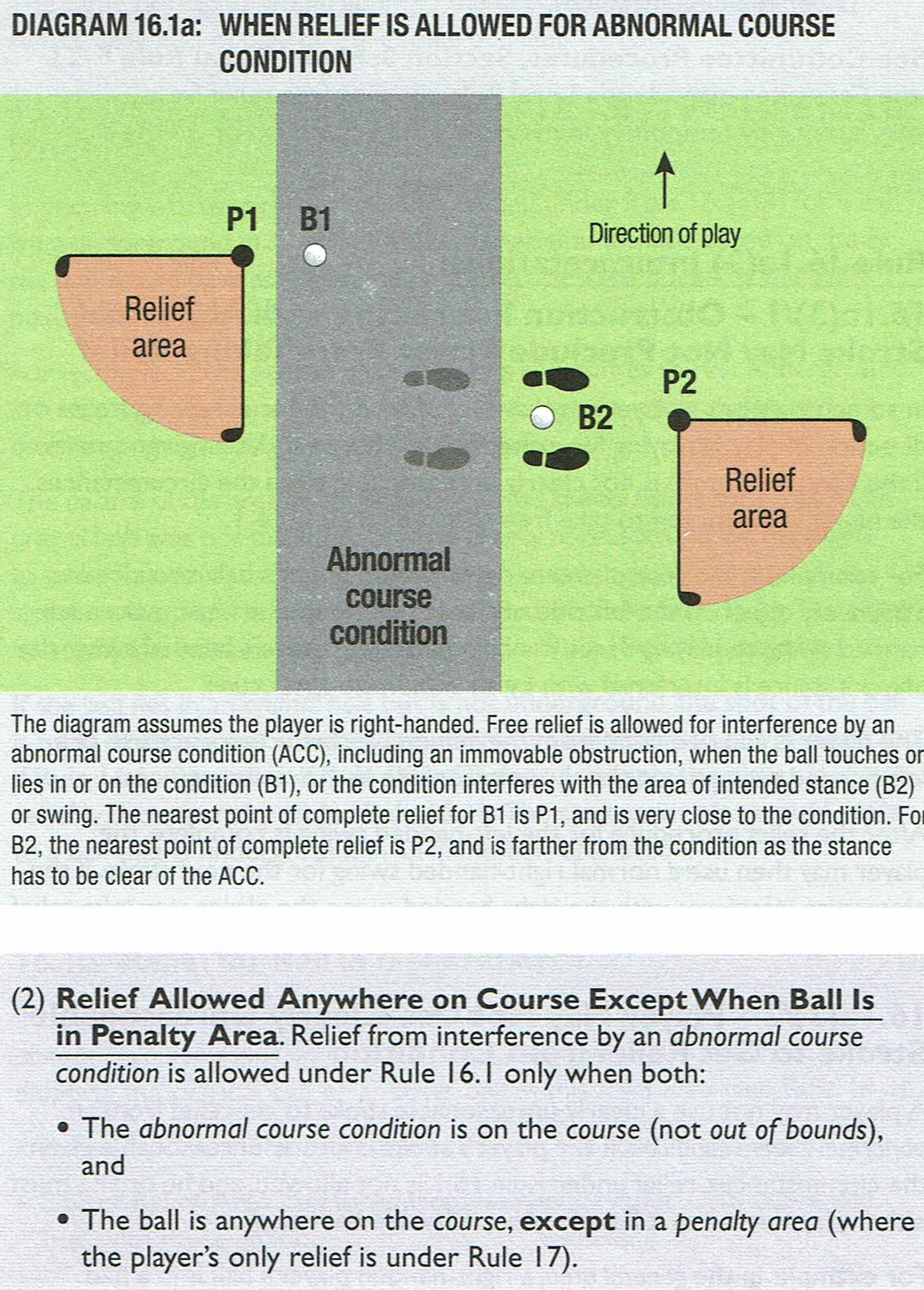
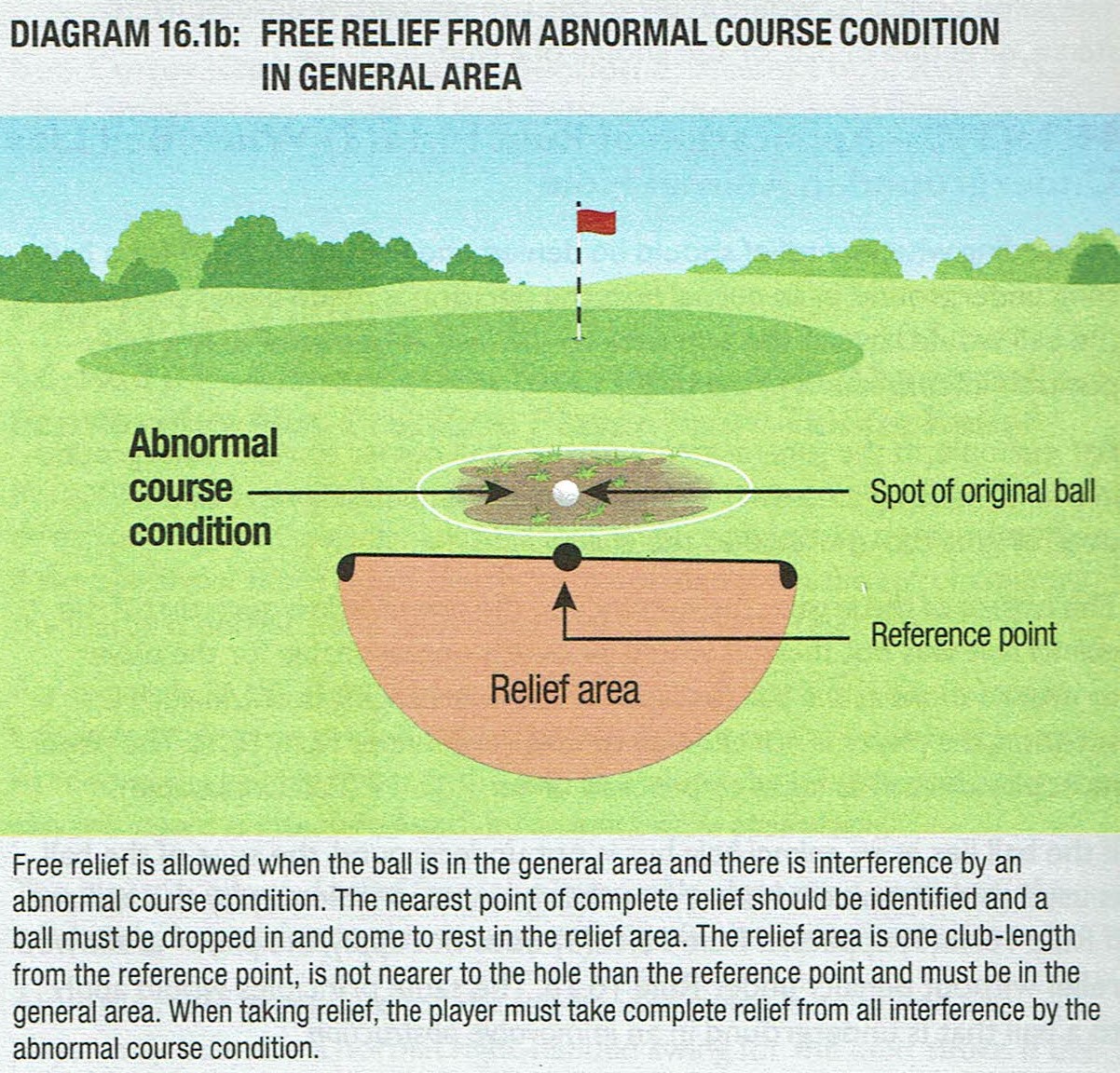
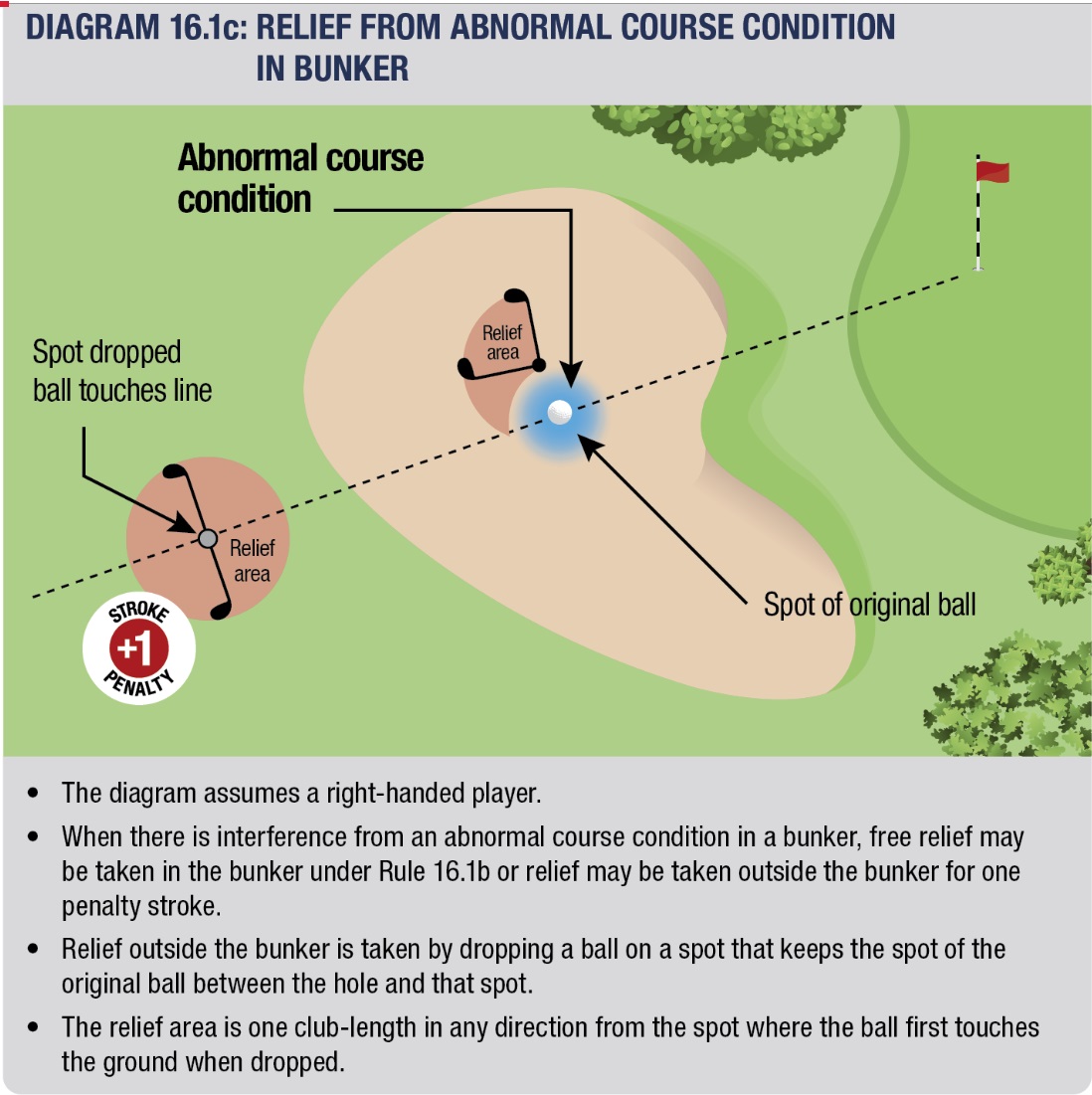
c. Relief for Ball in
Bunker
If
a
player’s ball is in a bunker
and there is interference by an
abnormal course condition on
the course, the player may take
either
free relief under (1), or penalty relief under (2):
(1) Free Relief: Playing
from Bunker. The player may
take free relief under Rule 16.1b, except that:
•
The nearest point of complete relief and the relief area must be in the
bunker.
•
If there is no such nearest point of complete relief in the bunker, the
player may still take this relief by using the point of maximum
available relief in the bunker as the reference point.
(2)
Penalty Relief:
Playing from Outside Bunker (Back-On-the-Line Relief).
For one
penalty stroke,
the player may drop the original ball or
another ball (see Rule 14.3) in a relief area
that
is based on a reference line going straight back from the hole through
the spot of the original ball:
•
Reference Point: A point on the course chosen by the player that is on
the reference line and is farther from the hole than that original spot
(with no limit on how far back on the line):
• In choosing
this reference point, the player should indicate the point by using an
object (such as a tee).
• If the player drops the ball without
having chosen this point, the
reference point is treated as being the point on the line that is the
same distance from the hole as where the dropped ball first touched the
ground.
•
Size
of Relief Area Measured from Reference Point:
One
club-length, but with these
limits:
• Must not be nearer the
hole than the reference point, and
• May be in any area of the course,
but
• If more than one area of the course
is located within one club-length
of the reference point, the ball must come to rest in the relief area
in the same area of the course that the ball first touched when dropped
in the relief area.
d.
Relief for
Ball on Putting Green
If a
player’s
ball is on
the putting green
and there is interference by an
abnormal
course condition on the
course, the player
may take free relief by
placing the original ball or another ball on the spot of the nearest
point of complete relief, using the procedures for replacing a ball
under Rules 14.2b(2) and 14.2e.
•
The nearest point of complete relief must be either on the putting
green or in the general area.
•
If there is no
such nearest point of complete relief, the player may still take this
free relief by using the point of maximum available relief as the
reference point, which must be either on the putting green or in the
general area.
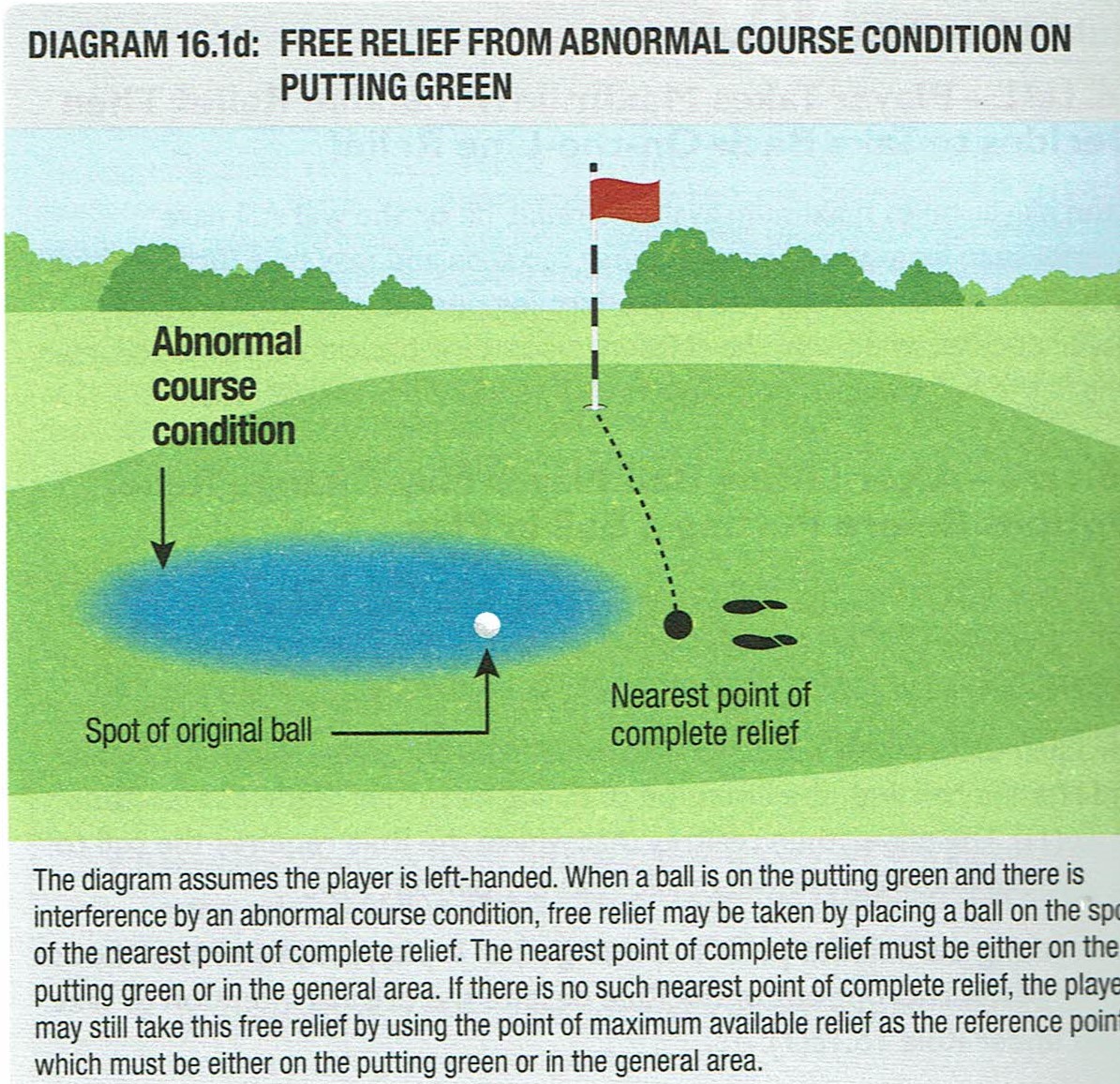
e. Relief for Ball Not
Found but Known to be In or On Abnormal Course Condition
If a
player’s
ball has not been found and it is known or virtually certain that the
ball came to rest in or on an abnormal course condition on the course,
the player may use this relief option instead of taking
stroke-and-distance relief:
•
The player may take relief under Rule 16.1b, c or d, using the
estimated point where the ball last crossed the edge of the abnormal
course condition on the course as the spot of the ball for purposes of
finding the nearest point of complete relief.
•
Once the player puts another ball in play to take relief in this way:
• The
original ball is no
longer in play and must not be played.
• This is true even if it is then
found on the course before the end of
the three minute search time (see Rule 6.3b)
But if it
is not known or
virtually certain that the
ball came to rest in or on an abnormal course condition and the ball is
lost, the player must take stroke-and-distance relief under Rule 18.2.
f.
Relief Must Be Taken
from Interference by No Play Zone (area of course where
play is prohibited
by course or committee) in
Abnormal Course Condition
In
each of
these situations, the ball must not be played as it lies:
(1) When Ball Is in No
Play Zone. If the
player’s ball is in a no play zone in or on an abnormal
course condition in the general area, in a bunker or on the putting
green:
•
No
Play Zone in General Area. The player must take free relief under Rule
16.1b.
•
No Play Zone in Bunker. The player must take free relief or penalty
relief under Rule 16.1c(1) or (2).
•
No Play Zone on Putting Green. The player must take free relief under
Rule 16.1d.
(2)
When No Play Zone
Interferes with Stance or Swing for Ball Anywhere on Course Except
Penalty Area. If a
player’s ball is outside a no play zone and is in the general
area, in a bunker or on the putting green; and a no play zone (whether
in an abnormal course condition or in a penalty area) interferes with
the player’s area of intended stance, or area of intended
swing, the player must either:
•
Take relief if allowed under Rule 16.1b, c or d, depending on whether
the ball is in the general area, in a bunker or on the putting green,
or
•
Take unplayable ball relief under Rule 19.
For
what to do when there is interference
by a no play zone for a ball in a
penalty area,
see Rule 17.1e.
Penalty
for Playing Ball from a Wrong Place in Breach of Rule 16.1: General Penalty
under Rule 14.7a.
16.2 Dangerous Animal Condition
A
“dangerous
animal condition” exists when a dangerous animal (such as
poisonous snakes, stinging bees, alligators, fire ants or bears) near a
ball could cause serious physical injury to the player if he or she had
to play the ball as it lies.
a. When Relief Is Allowed
A player
may take
relief under
Rule
16.2b from
interference by a
dangerous animal condition no
matter where his or her ball is on
the
course, except
that relief
is not allowed:
•
When
playing
the ball as it lies is clearly unreasonable because of something other
than the dangerous animal condition (for example, when a player is
unable to make a stroke because of where the ball lies in a bush), or
• When
interference exists only because the player chooses a club, type of
stance or swing or direction of play that is clearly unreasonable under
the circumstances.
b. Relief For
Dangerous Animal Condition
(1)
When Ball Is
Anywhere Except Penalty Area.
The player
may
take relief under Rule 16.1b,
c or d, depending on whether the
ball is
in the general area, in a bunker or on the putting green.
(2)
When Ball Is in
Penalty Area. The
player may take free
relief or penalty relief:
•
Free
Relief: Playing
from Inside Penalty Area. The
player may take free relief under Rule 16.1b, except that the nearest
point of complete relief and the relief area must be in the penalty
area.
•
Penalty Relief:
Playing from Outside Penalty
Area.
• The
player may take penalty relief under Rule
17.1d.
• If there is interference by a
dangerous animal condition
where the ball would be played after taking this penalty relief outside
the penalty area, the player may take further relief under (1) without
additional penalty.
For purposes of this
Rule, the nearest
point of complete
relief means the nearest point (not nearer the hole) where the
dangerous animal condition does not exist.
Penalty for Playing Ball from a Wrong Place in Breach of Rule
16.2: General
Penalty
under Rule 14.7a.
16.3 Embedded Ball
a. When Relief Is Allowed
(1)
Ball Must Be Embedded in General Area. Relief is allowed under
Rule 16.3b only
when a player’s ball is embedded in the general area.
•
There is no
relief under this Rule if the ball is embedded anywhere except in the
general area.
•
But if the ball is embedded on the putting green, the player may mark
the spot of the ball and lift and clean the ball, repair the damage
caused by the ball’s impact, and replace the ball on its
original spot (see Rule 13.1c(2)).
Exceptions
– When
Relief Not Allowed for Ball
Embedded in General Area:
Relief under Rule 16.3b is not allowed:
•
When the ball is embedded in sand in a part of the general area that is
not cut to fairway height or less, or
•
When interference
by anything other than the
ball being embedded makes
the stroke clearly unreasonable
(for example, when a player is
unable
to make a stroke because of where the ball lies in a bush).
(2) Determining Whether
Ball Is Embedded. A
player’s ball is embedded only if:
• It is in its
own pitch-mark made as a result of the player’s previous
stroke, and
•
Part of the ball is below the level of the ground.
A
ball
is not embedded if it is
below the level of the ground as a
result of anything other than the player’s previous stroke,
such as when:
•
The ball is pushed into the ground by someone stepping on it,
• The ball is driven straight into the ground without becoming
airborne, or
• The ball was dropped in taking relief under a Rule.
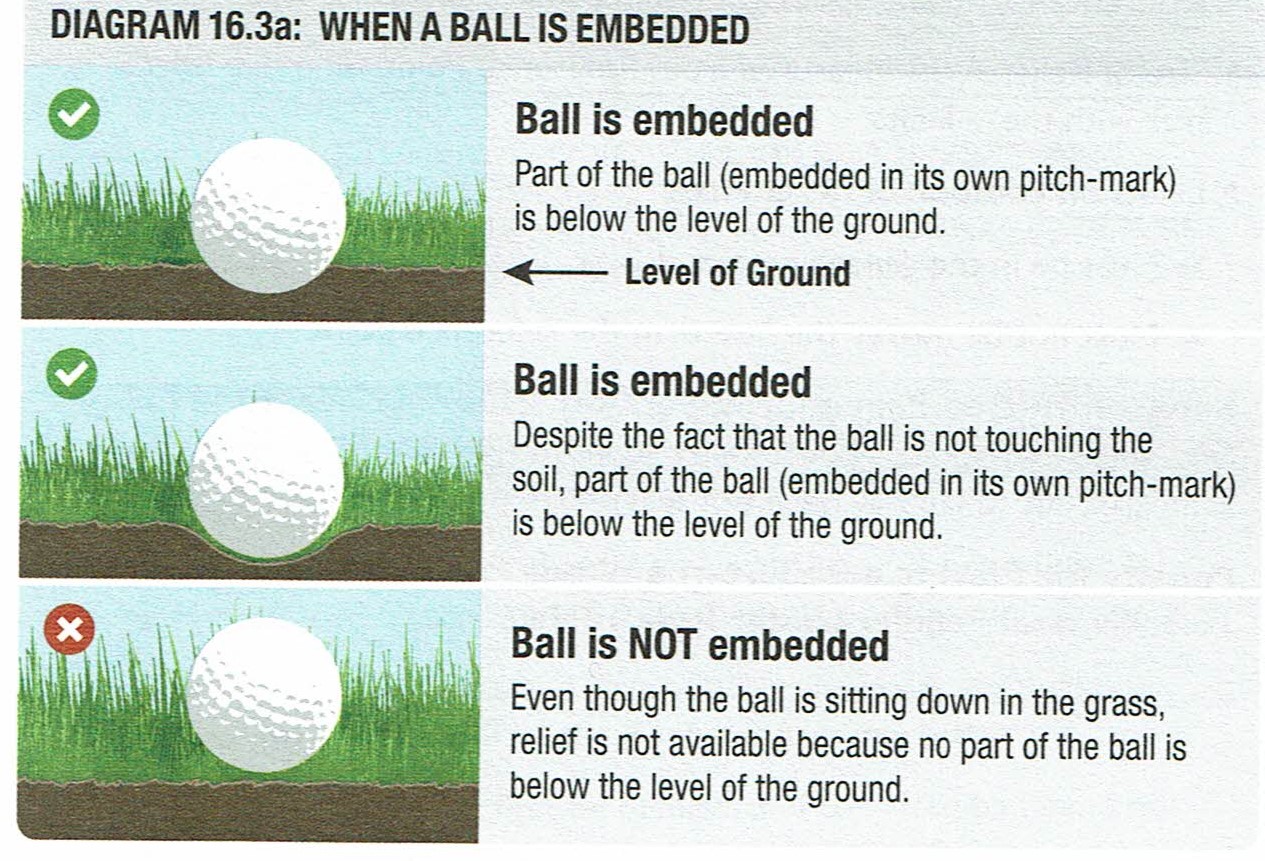
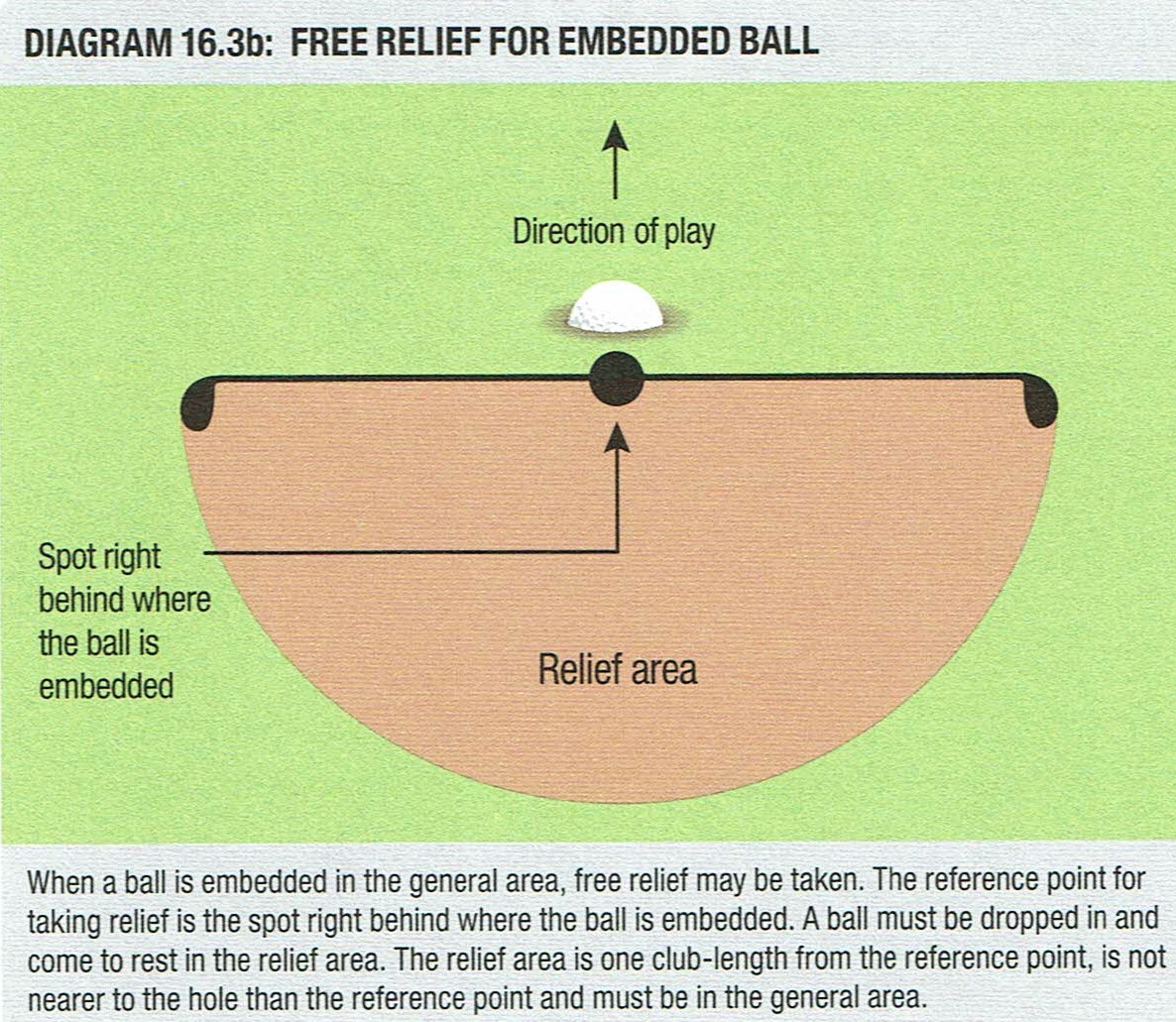
b. Relief for
Embedded Ball
When
a player’s
ball is embedded in the general area and relief is allowed under Rule
16.3a, the player may take free relief by dropping the original ball or
another ball in this relief area (see Rule 14.3):
•
Reference
Point: The spot right behind where the ball is embedded.
•
Size of Relief Area Measured from Reference Point: One club-length, but
with these limits:
•
Limits on Location of Relief Area:
•
Must be in
the general area, and
•
Must not be nearer the hole than the reference
point.
Penalty
for Playing a Ball from a Wrong Place in Breach of Rule 16.3: General Penalty
under Rule 14.7a.
16.4
Lifting Ball to See If It Lies in Condition Where Relief Allowed
If a
player
reasonably believes that his or her ball lies in a condition where free
relief is allowed under Rule 15.2, 16.1 or 16.3, but cannot decide that
without lifting the ball:
•
The player may
lift the ball to see
if
relief is allowed, but:
•
The spot
of the ball must first be marked,
and the lifted ball must not be
cleaned (except on the
putting green)
(see Rule 14.1).
If
the player lifts the
ball without having this reasonable belief (except on the putting green
where the player may lift under Rule 13.1b), he gets one penalty stroke.
If
relief is allowed and the player takes relief, there is no penalty even
if the player did not mark the spot of the ball before lifting it, or
cleaned the lifted ball.
If
relief is not allowed, or if the player chooses not to take relief that
is allowed:
•
The player gets one penalty stroke
if he did not mark the spot of the ball before lifting it, or
cleaned the lifted ball when not allowed, and
•
The ball must be replaced on its original spot (see Rule
14.2).
Penalty
for Playing
Incorrectly Substituted Ball or Playing Ball from a Wrong Place in
Breach of Rule 16.4: General
Penalty
under Rule 6.3b or 14.7a.
VII
- PENALTY
RELIEF (RULES 17 & 19)
Rule
17
– Penalty Areas
Rule
17 is a specific Rule for penalty areas, which are bodies of water or
other areas defined by the Committee where a ball is often lost or
unable to be played. For one
penalty stroke, players may
use specific relief options to play a ball from outside the penalty
area.
17.1 Options for Ball in
Penalty Area
Penalty areas are defined as either red or yellow. This
affects the player’s relief options (see Rule 17.1d).
A player may stand in a penalty area to play a ball outside
the penalty area, including after taking relief from the penalty area.
a. When Ball Is in Penalty
Area
A
ball is in a penalty area when any part of the ball:
•
Lies on or
touches the ground or anything else (such as any natural or artificial
object) inside the edge of the penalty area, or
•
Is above the edge or any other part of the penalty area.
If part of the ball is both in a penalty area and in another area of
the course, see Rule 2.2c.
The
player may either:
•
Play the ball
as it lies without penalty, under the same Rules that apply to a ball
in the general area (specific limitations on how a ball may be played
from a penalty area), or
•
Play a ball from outside the penalty area by taking penalty relief
under Rule 17.1d or 17.2.
Exception
– Relief Must Be Taken from Interference by No Play Zone in
Penalty Area (see Rule 17.1e).
If
a player’s ball has not been found and it is known or
virtually certain that the ball came to rest in a penalty area:
•
The player may
take penalty relief under Rule 17.1d or 17.2.
•
Once the player puts another ball in play to take relief in this way:
The original ball is no longer in play and must not be played.
This is true even if it is then found on the course before the end of
the three minute search time (see Rule 6.3b).
But if it is not known or virtually certain that the ball came to rest
in a penalty area and the ball is lost, the player must take
stroke-and-distance relief under Rule 18.2.
If
a player’s ball is in a penalty area, including when it is
known or virtually certain to be in a penalty area even though not
found, the player has these relief options, each for one penalty
stroke:
(1)
Stroke-and-Distance Relief.
The player may play the original ball or another ball from where the
previous stroke was made (see Rule 14.6).
(2) Back-On-the-Line Relief.
The player may drop the original ball, or another ball (see Rule 14.3),
in a relief area that is based on a reference line going straight back
from the hole through the estimated point where the original ball last
crossed the edge of the penalty area:
•
Reference Point: A point on the course chosen by the player that is on
the reference line and is farther from the hole than the estimated
point (with no limit on how far back on the line):
• Mark the point, the player
must drop the ball on the line and the ball must come to rest within
one club length in any direction of where it first touched the line, not in the same penalty
area.
• If
more than one area of the course is located within one club-length of
the reference point, the ball must come to rest in the relief area in
the same area of the course that the ball first touched when dropped in
the relief area.
(3) Lateral Relief (Red Penalty Area Only).
When the ball last crossed
the edge of a red penalty area, the player may drop the original ball
or another ball in this lateral relief area (Rule 14):
•
Reference
Point: The estimated point where the original ball last crossed the
edge of the red penalty area.
• Mark
the point, drop
ball within two club-lengths,
no closer to hole, not
in same penalty area.
• If
more than one area of the course is located within two club-lengths of
the reference point, the ball must come to rest in the relief area in
the same area of the course that the ball first touched when dropped in
the relief area.
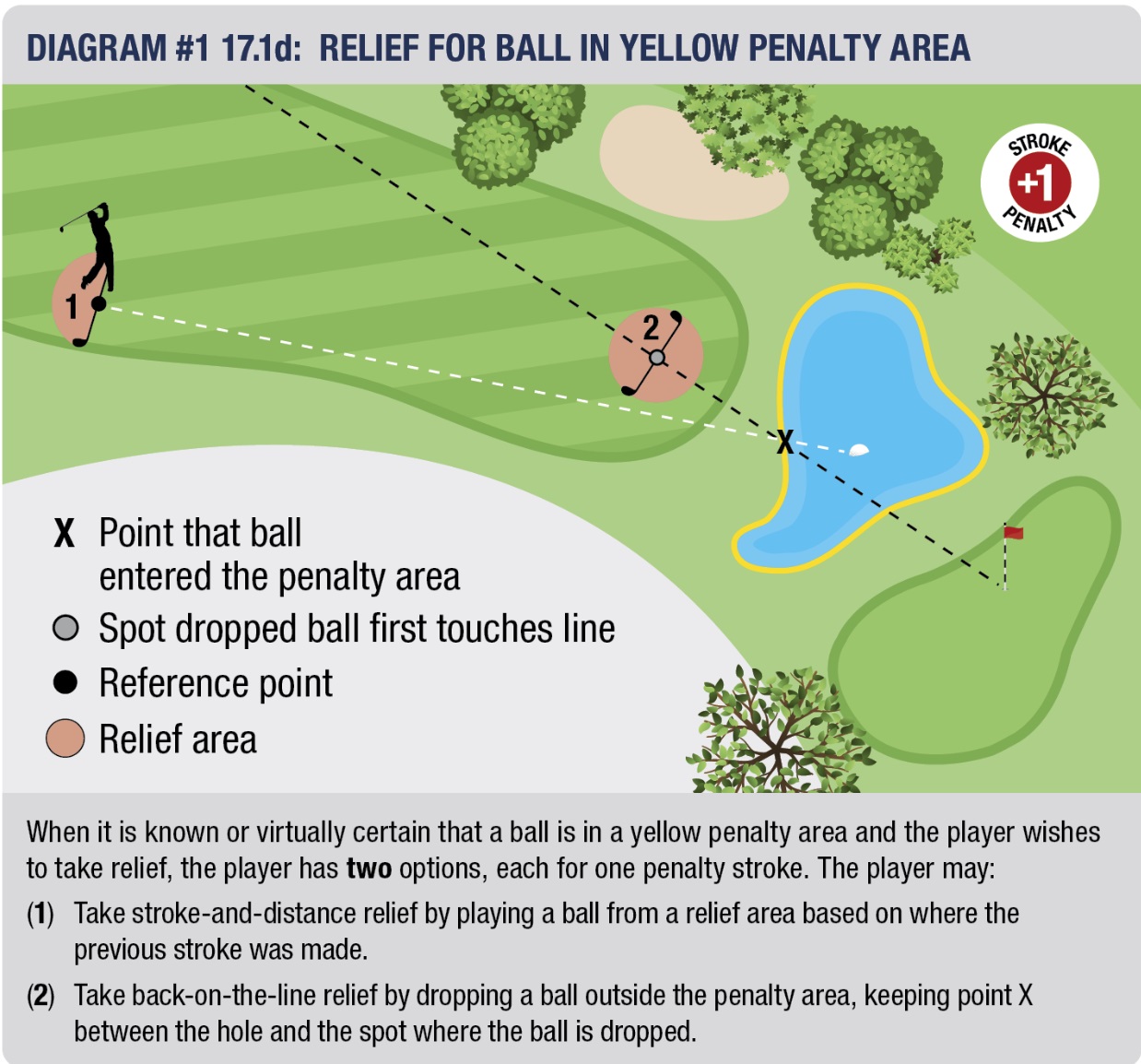
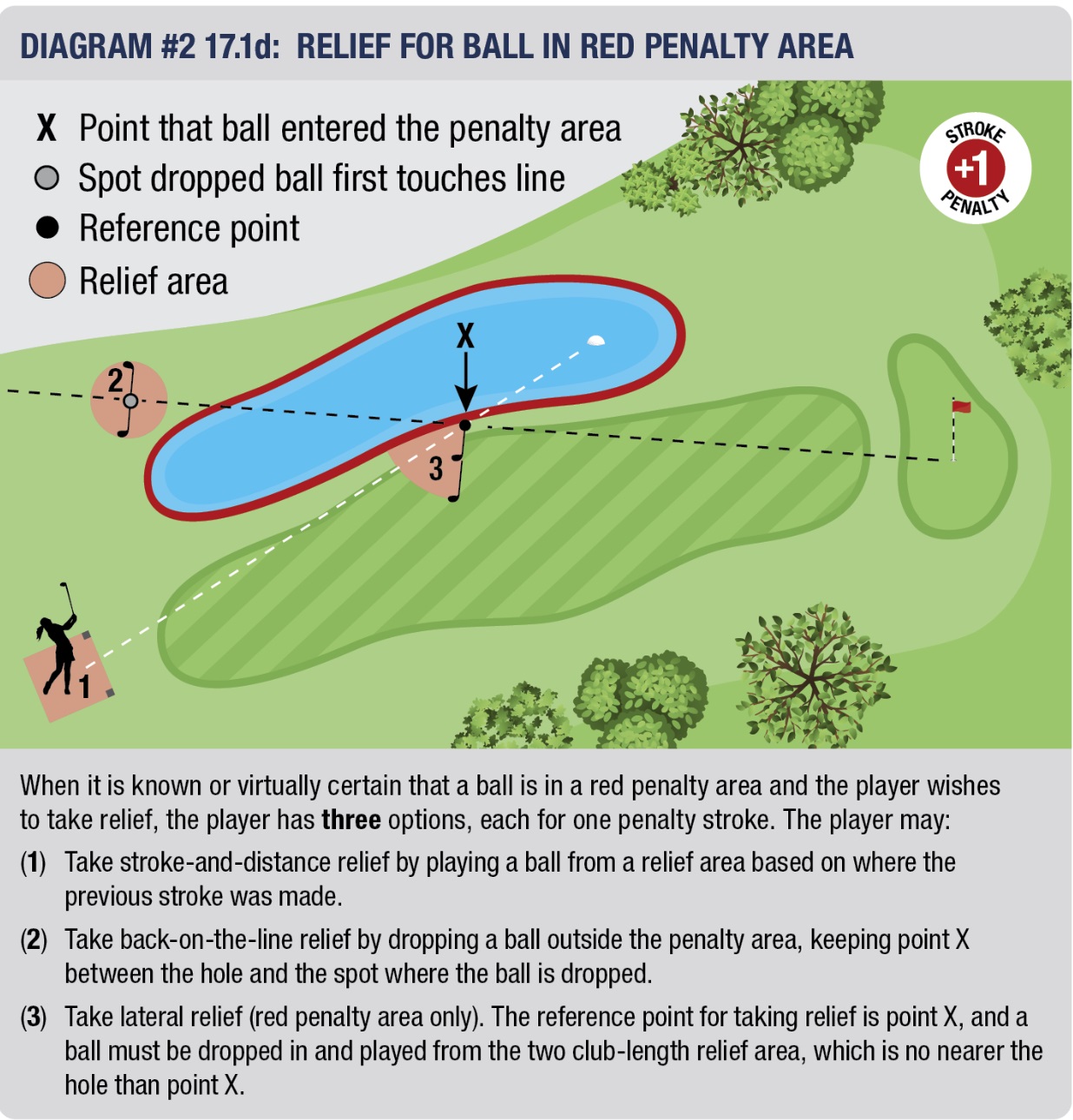
e. Relief Must
Be Taken from Interference by
No Play Zone in Penalty Area
In
each of these situations, the player must
not play the ball as it lies:
(1)
When Ball Is in No Play Zone in Penalty Area.
The player must take penalty relief under Rule 17.1d or 17.2.
(2)
When No Play Zone on Course Interferes with Stance or Swing for
Ball in Penalty Area.
If
a player’s ball is in a penalty area, and is outside a no
play zone but a no play zone (whether in an abnormal course condition
or in a penalty area) interferes with his or her area of intended
stance or area of intended swing, the player must either:
•
Take penalty
relief outside the penalty area under Rule 17.1d or 17.2, or
•
Take free relief by dropping the original ball or another ball in this
relief area (if it exists) in the penalty area (see Rule 14.3):
• Reference Point:
The nearest point of complete relief from the no play
zone. Drop within one club-length, not nearer the hole, in the same
penalty area where the ball lies.
But
there is no free relief from
interference by the no play zone under
(2):
•
When playing
the ball as it lies is clearly
unreasonable
because of something other than
the no play zone (for example, when a
player is unable to make a stroke because of where the ball lies in a
bush), or
•
When interference
exists only because the
player chooses a
club, type of stance or swing, or direction of play that is clearly
unreasonable under the circumstances.
For what to do when there is interference by a no play zone for a ball
anywhere except in a penalty area, see Rule 16.1f.
Penalty
for Playing Ball from a Wrong Place in Breach of Rule 17.1:
General
Penalty under Rule
14.7a.
17.2
Options After Playing Ball from Penalty Area
a.
When Ball Played from Penalty Area Comes to Rest in Same or Another
Penalty Area
If
a ball played from a penalty area comes to rest in the same penalty
area or another penalty area, the
player may play the ball as it lies
(see Rule 17.1b)., or
for
one
penalty stroke, the player
may take relief under any of these
options:
(1)
Normal Relief Options. The
player may take stroke-and-distance relief, back-on-the-line
relief, or,
for a red penalty area, lateral relief under Rule 17.1d(1, 2,or
3).
Under
Rule 17.1d(2) or (3), the estimated point used to determine the relief
area is where the original ball last crossed the edge of the penalty
area where the ball now lies.
If
the player takes stroke-and-distance relief by dropping a ball in the
penalty area (see Rule 14.6) and then decides not to play the dropped
ball from where it comes to rest:
•
The player may take further relief outside the penalty area under Rule
17.1d(2) or (3) (for a red penalty area) or under Rule 17.2a(2).
•
If the player does so, he or she gets one more penalty stroke, for a
total of two penalty strokes: one stroke for taking stroke-and-distance
relief, and one stroke for taking relief outside the penalty area.
(2)
Extra Relief Option:
Playing from Where Last Stroke Made Outside a
Penalty Area. Instead of using one of the normal relief options under
(1), the player may choose to play the original ball or another ball
from where he or she made the last stroke from outside a penalty area
(see Rule 14.6).
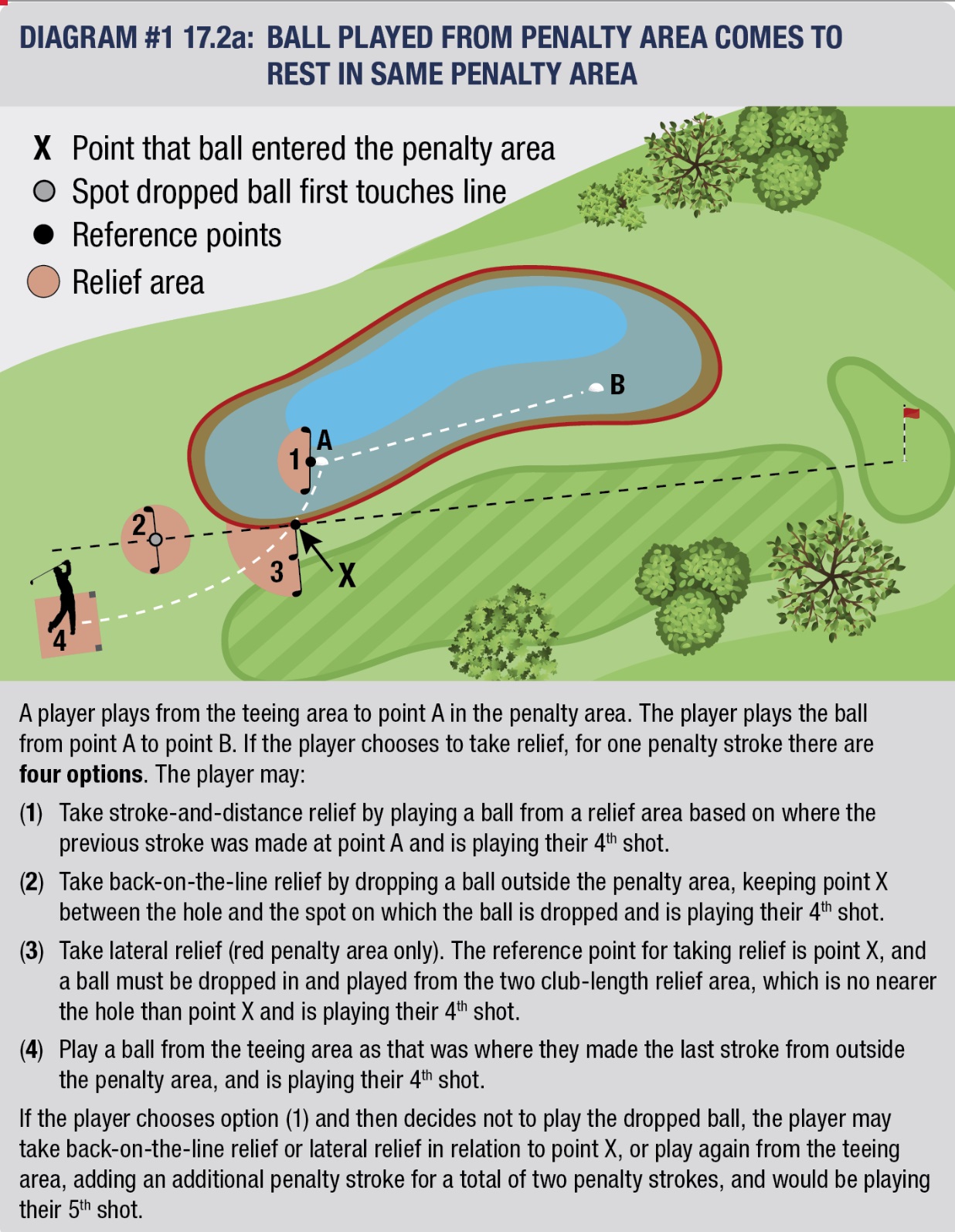
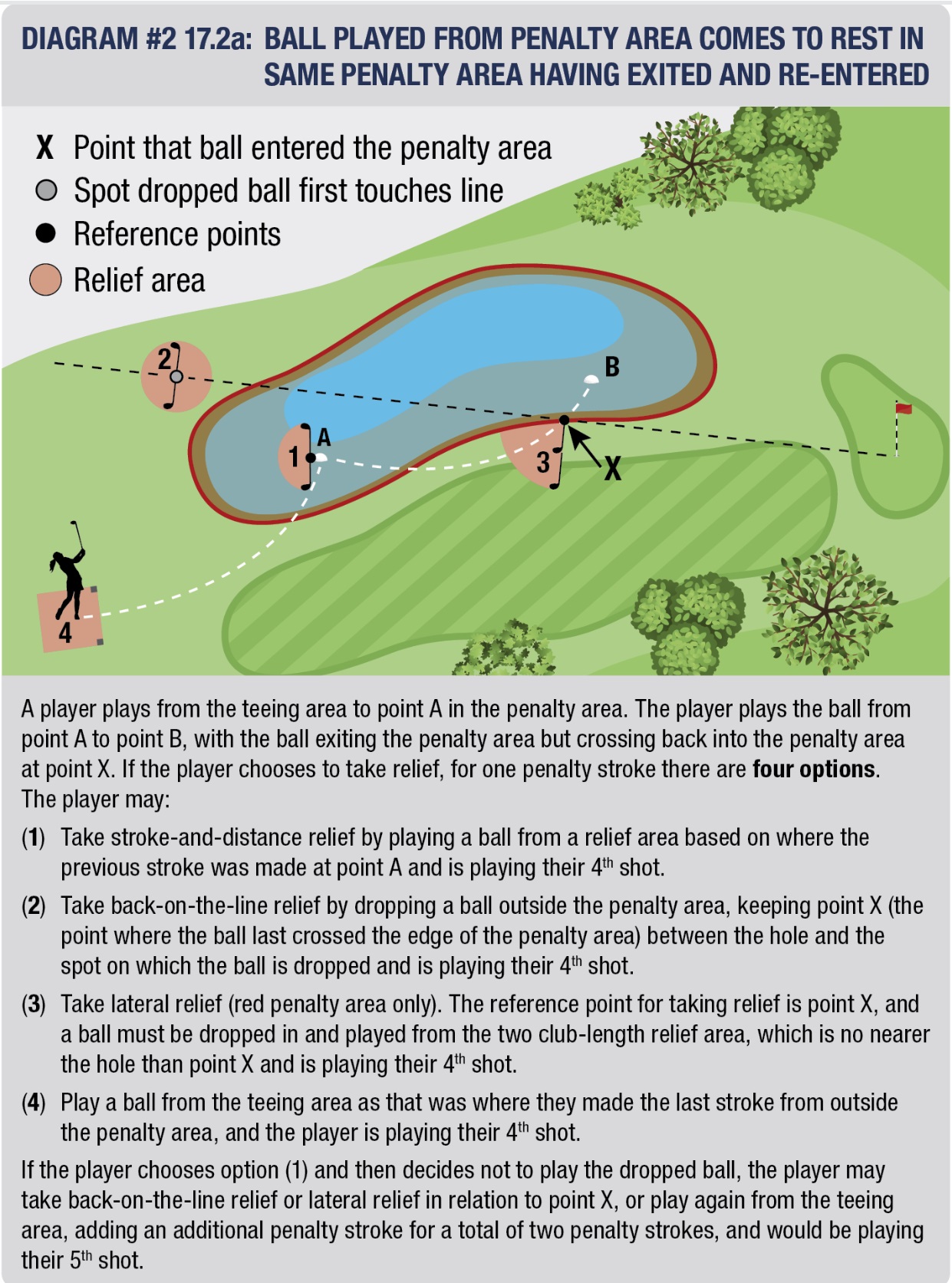
b.
When Ball Played from Penalty Area Is Lost, Out of Bounds or Unplayable
Outside Penalty Area
After
playing a ball from a penalty area, a player may sometimes be required
or choose to take stroke-and-distance relief because the original ball
is either:
•
Out of bounds or lost outside the penalty area (see Rule 18.2), or
•
Unplayable outside the penalty area (see Rule 19.2a).
If
the player takes stroke-and-distance relief by dropping a ball in the
penalty area (see Rule 14.6) and then decides not to play the dropped
ball from where it comes to rest:
•
The player may take further relief outside the penalty area under Rule
17.1d(2) or (3) (for a red penalty area) or under Rule 17.2a(2)
•
If the player does so, he gets one
more penalty
stroke,
for a
total of two penalty strokes:
one stroke for taking stroke-and-distance
relief, and one stroke for taking relief outside the penalty area.
The
player may directly take such relief outside the penalty area without
first dropping a ball in the penalty area, but still gets a total of
two penalty strokes.
Penalty
for Playing Ball from a Wrong Place in Breach of Rule 17.2: General
Penalty under Rule 14.7a.
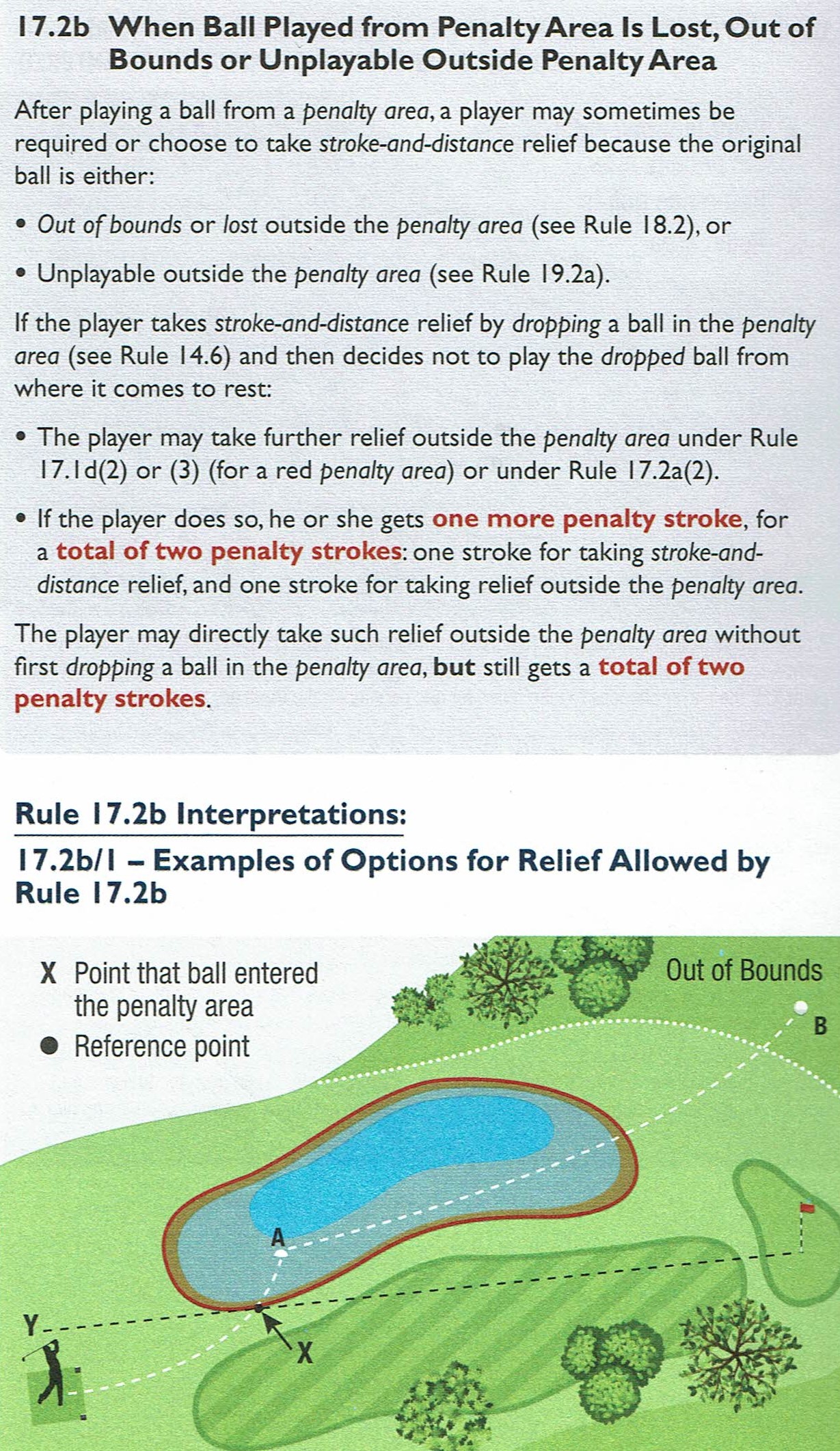
17.3
No Relief under Other Rules for Ball in Penalty Area
When a player’s
ball is in a penalty area, there is no
relief for:
•
Interference by an abnormal course
condition
(Rule 16.1),
•
An embedded
ball (Rule 16.3), or
•
An unplayable
ball (Rule 19).
The
player’s only relief option
is to take penalty relief
under
Rule 17.
But
when a dangerous animal
condition interferes with the play of a ball in
a penalty area, the player may take either free relief in the penalty
area or penalty relief outside the penalty area (see Rule 16.2b(2)).
Rule
18 –
Stroke-and-Distance Relief, Ball Lost or Out of Bounds, Provisional
Ball - Local Rule is
presented after this Rule
Rule 18
covers taking
relief under penalty of stroke and distance.
When a ball is lost outside a penalty area, or comes to rest out of
bounds, the required progression of playing from the teeing area to the
hole is broken; the player must resume that progression by playing
again from where the previous stroke was made. This Rule also covers
how and when a provisional ball may be played to save time when the
ball in play might have gone out of bounds or be lost outside a penalty
area.
18.1 Relief under Penalty
of Stroke and Distance Allowed at Any Time
At any
time, a player
may take stroke-and-distance relief by adding
one
penalty stroke and playing
the original ball, or another ball, from where the previous stroke was
made (see Rule 14.6).
The
player always has this stroke-and-distance relief option:
•
No matter where the player’s ball is on the course, and
•
Even when a Rule requires the player to take relief in a certain way,
or to play a ball from a certain place.
Once
the player puts another ball in play under penalty of stroke and
distance (see Rule 14.4):
•
The original ball is no longer in play and must not be played.
•
This is true even if the original ball is then found on the course
before the end of the three-minute search time (see Rule 6.3b).
But
this does not apply to a ball to be played from where the previous
stroke was made when the player:
•
Announces that he or she is playing a provisional ball (see Rule
18.3b),
•
Is playing a second ball in stroke play under Rule 14.7b or 20.1c(3).
18.2
Ball Lost or Out of Bounds: Stroke-and-Distance Relief Must Be Taken
a.
When Ball Is Lost or Out of Bounds
(1)
When Ball Is Lost. A ball is
lost if not
found in three minutes after the player or his or her caddie begins to
search for it.
If
a ball is
found in that time but it is uncertain whether it is the
player’s ball:
•
The player must promptly attempt to identify the ball (see Rule 7.2)
and is allowed a reasonable time to do so, even if that happens after
the three-minute search time has ended.
•
This includes a reasonable time to get to the ball if the player is not
where the ball is found.
If
the player
does not identify his or her ball in that reasonable time, the ball is
lost.
(2)
When Ball Is Out of Bounds. A
ball at rest is out of
bounds only when all of it is outside the boundary edge of the course.
A
ball is in
bounds when any part of the ball:
•
Lies on or touches the ground or anything else (such as any natural or
artificial object) inside the boundary edge, or
•
Is above the boundary edge or any other part of the course.
A
player may stand out of bounds to play a ball on the course.
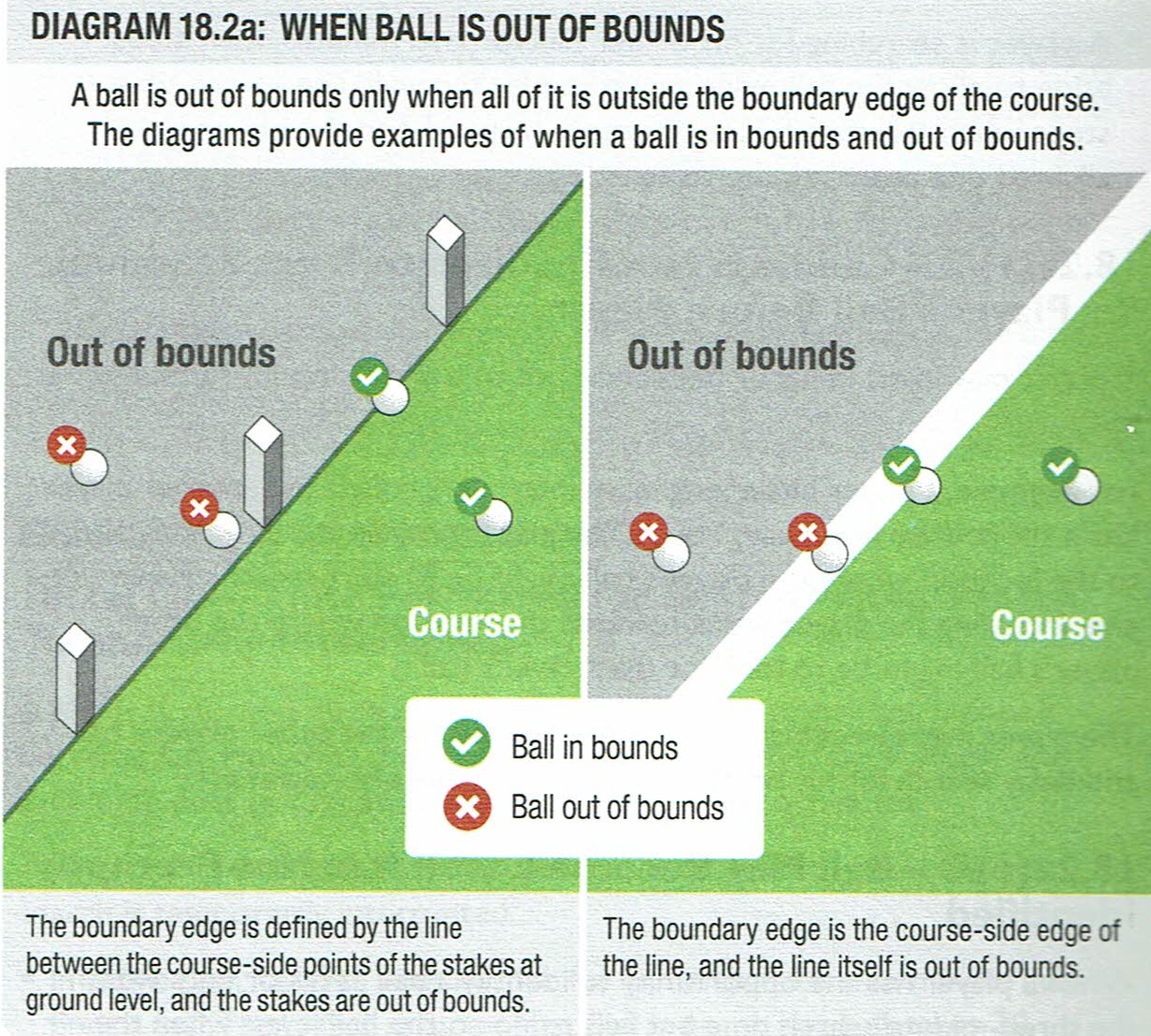
b.
What to Do When Ball Is Lost or Out of Bounds
If a
ball is lost or out
of bounds, the player
must take stroke-and-distance
relief by adding one
penalty stroke and playing
the original ball, or another ball, from where the previous stroke was
made (see Rule 14.6).
Exception
– Player May Substitute
Another Ball under Other Rule When It Is Known or Virtually Certain
What Happened to Ball:
Instead of taking stroke-and-distance relief, the player may substitute
another ball as allowed under a Rule that applies when his or her ball
has not been found and it is known or virtually certain that the ball:
•
Came to rest on the course and was moved by an outside influence (see
Rule 9.6) or played as a wrong ball by another player (see Rule
6.3c(2)),
•
Came to rest on the course in or on a movable obstruction (see Rule
15.2b) or an abnormal course condition (see Rule 16.1e),
•
Is in a penalty area (see Rule 17.1c), or
•
Was deliberately deflected or stopped by any person (see Rule
11.2c).
Penalty
for Playing Ball
from a Wrong Place in Breach of Rule 18.2: General Penalty
under Rule 14.7a.
18.3 Provisional Ball
a.
When Provisional Ball Is Allowed
If a
ball might be lost
outside a penalty area or be out of bounds, to save time the player may
play another ball provisionally under penalty of stroke and distance
(see Rule 14.6).
For
a ball that might be lost, this applies:
•
When the original ball has not been found and identified and is not yet
lost, and
•
When a ball might be lost in a penalty area but also might be lost
somewhere else on the course.
But
if the player is aware that the only possible place the original ball
could be lost is in a penalty area, a provisional ball is not allowed
and a ball played from where the previous stroke was made becomes the
player’s ball in play under penalty of stroke and distance
(see Rule 18.1).
If
a provisional ball itself might be lost outside a penalty area or be
out of bounds:
•
The player may play another provisional ball.
•
That provisional ball then has the same relationship to the first
provisional ball as the first one has to the original ball.
b.
Announcing Play of Provisional Ball
Before
the stroke is
made, the player must announce that he or she is going to play a
provisional ball:
•
It is not enough for the
player only to say that he or she is playing another ball or is playing
again.
•
The
player must use the word
“provisional” or
otherwise clearly indicate that he or she is playing the ball
provisionally under Rule 18.3.
If
the player does not announce this (even if he intended to play
a provisional ball) and plays a ball from where the previous stroke was
made, that ball is the player’s ball in play under
penalty of stroke and distance
(see Rule 18.1).
c. Playing Provisional Ball Until It Becomes the Ball in Play or Is
Abandoned
(1)
Playing Provisional Ball More Than Once. The player
may continue to play the provisional ball, without it losing its status
as a provisional ball, so long as it is played from a spot that is the
same distance or farther from the hole than where the original ball is
estimated to be. This is true
even if the
provisional ball is played several times.
But
it
stops being a provisional ball when
it becomes the ball in play under (2), or is abandoned under (3) and
therefore becomes a wrong ball.
(2) When Provisional Ball Becomes Ball in Play. The provisional ball
becomes the player’s ball in play under penalty
of stroke and distance in
either of these two cases:
•
When Original Ball Is Lost
Anywhere on Course Except in Penalty Area or Is Out of Bounds.
The original ball is no longer in play (even if it is then found on the
course after the end of the three-minute search time) and is now a
wrong ball that must not be played (see Rule 6.3c).
•
When
Provisional Ball Is Played from Spot Nearer Hole Than Where Original
Ball Is Estimated to Be. The
original ball is no longer in play (even if it is then found on the
course before the end of the three-minute search time or is found
nearer the hole than had been estimated) and is now a wrong ball that
must not be played (see Rule 6.3c).
If
the player plays a
provisional ball into the same general location as the original ball
and is unable to identify which ball is which:
•
If only one of the balls is found on the course, that ball is treated
as the provisional ball which is now in play.
•
If both balls are found on the course, the player must choose one of
the balls to be treated as the provisional ball which is now in play,
and the other ball is treated as lost and must not be played.
Exception
– Player May
Substitute Another Ball Under Other Rule When It Is Known or Virtually
Certain What Happened to Ball: The player has an extra option when his
or her ball has not been found and it is known or virtually certain
that the ball:
•
Came to rest on the course and was moved by an outside influence (see
Rule 9.6),
•
Came to rest on
the course in or on a movable obstruction (see Rule 15.2b) or an
abnormal course condition (see Rule 16.1e), or
•
Was deliberately
deflected or stopped by any person (see Rule 11.2c).
When
one of those Rules
applies, the player may either:
•
Substitute another ball as allowed under that Rule, or
•
Treat the provisional ball as the ball in play under penalty of stroke
and distance.
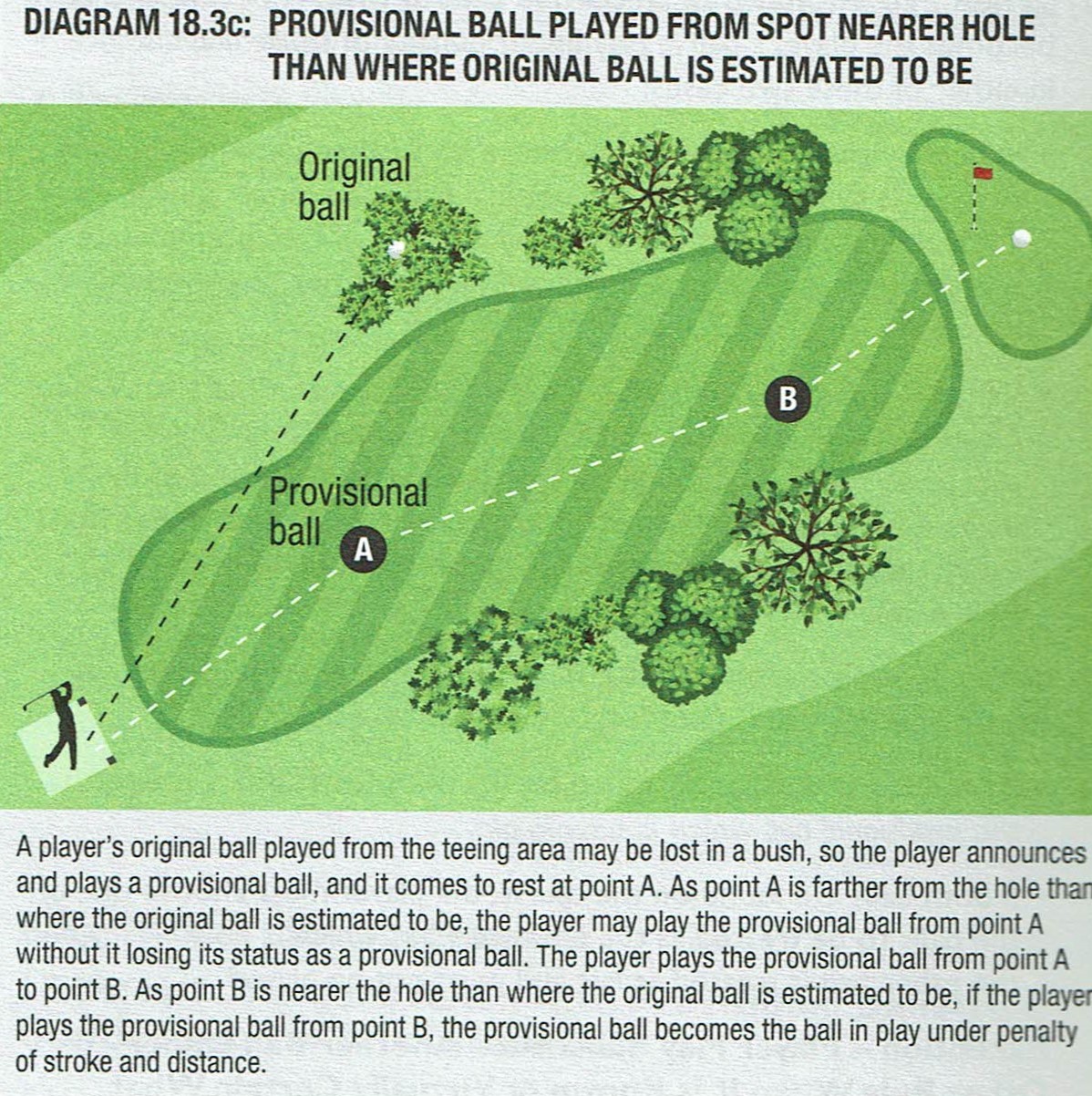
(3) When Provisional Ball Must Be Abandoned. When a provisional ball
has not yet become the ball in play, it must be abandoned in either of
these two cases:
•
When Original Ball Is
Found on Course Outside Penalty Area Before the End of the Three Minute
Search Time. The player must
play the original ball as it lies.
•
When
Original Ball Is Found in Penalty Area or Is Known or Virtually Certain
to Be in Penalty Area. The
player must either play the original ball as it lies or take penalty
relief under Rule 17.1d.
In either case:
•
The player must not make any more strokes with the provisional ball
which is now a wrong ball (see Rule 6.3c), and
•
All strokes with that provisional ball before it was abandoned
(including strokes made and any penalty strokes solely from playing
that ball) do not count.
Penalty
for Playing Ball from a Wrong Place in Breach of Rule 18.3: General Penalty
under Rule 14.7a.
Rule
18L - RVSGT Local Rule Supplement
This rule is being implemented for improved pace of play.
Following a player's
stroke, if his ball might be lost outside a
penalty area, or be out of bounds, to save time the player may
play
another ball provisionally under
penalty of stroke and distance
under Rule 18.3 above: or,
the player may proceed to search for his original ball. If his
ball has not
been found within
the 3
minute search time, or when
the ball is known
or virtually certain to be out-of-bounds,
the player must proceed
under
this local rule, and does not have the option of replaying the previous
stroke under stroke and distance.
If the player proceeds with 18.3, and plays a provisional ball, this
local rule is no longer an option, unless
the provisional ball is also lost or out-of-bounds. The player must
then proceed with this local rule for the provisional ball, or pick up
for Triple
Bogey Max on the hole in play.
Local Rule
- For
two penalty strokes, the player may take
relief by dropping a ball in the applicable relief
area illustrated in one of
the next three images:
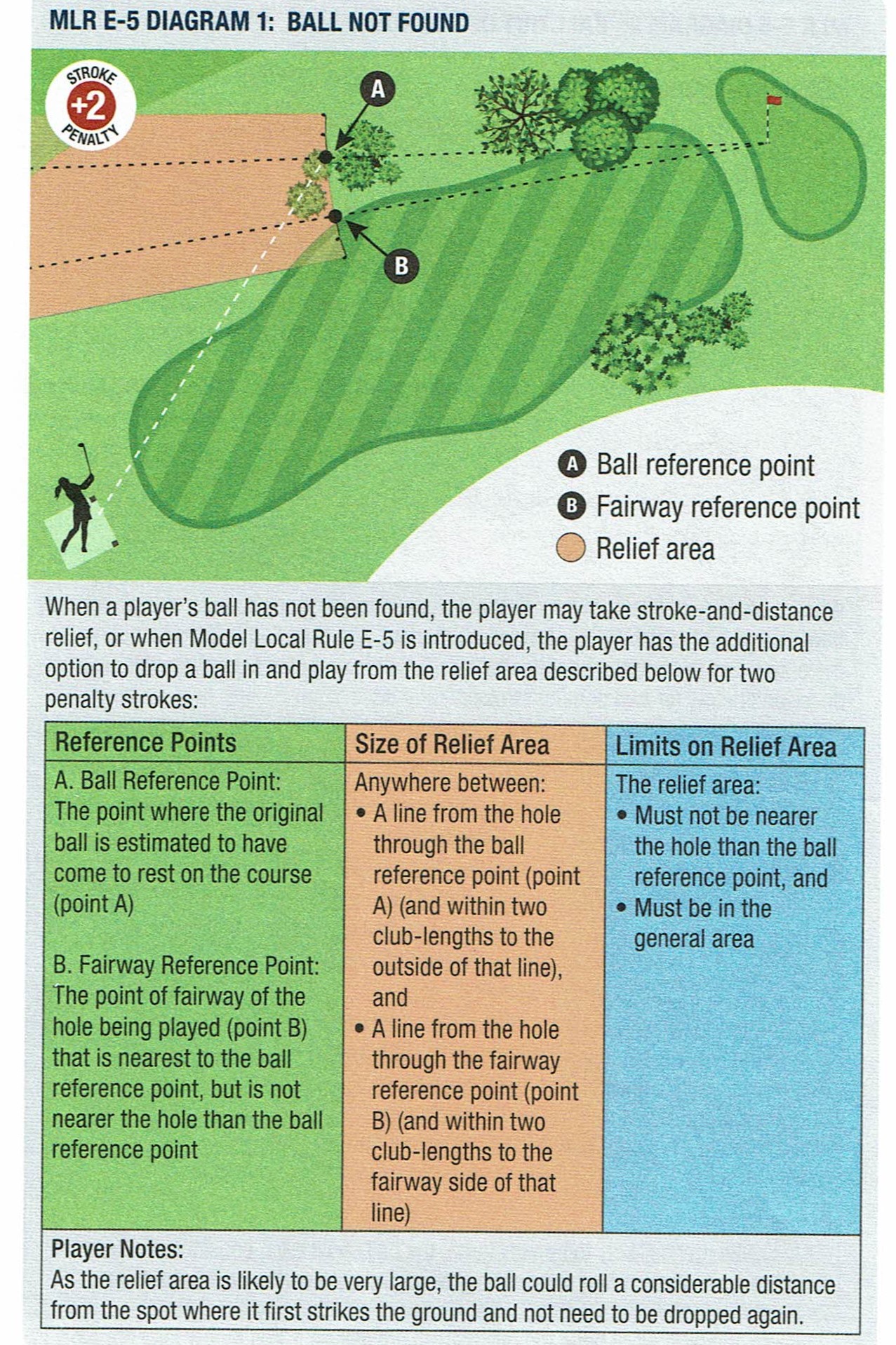
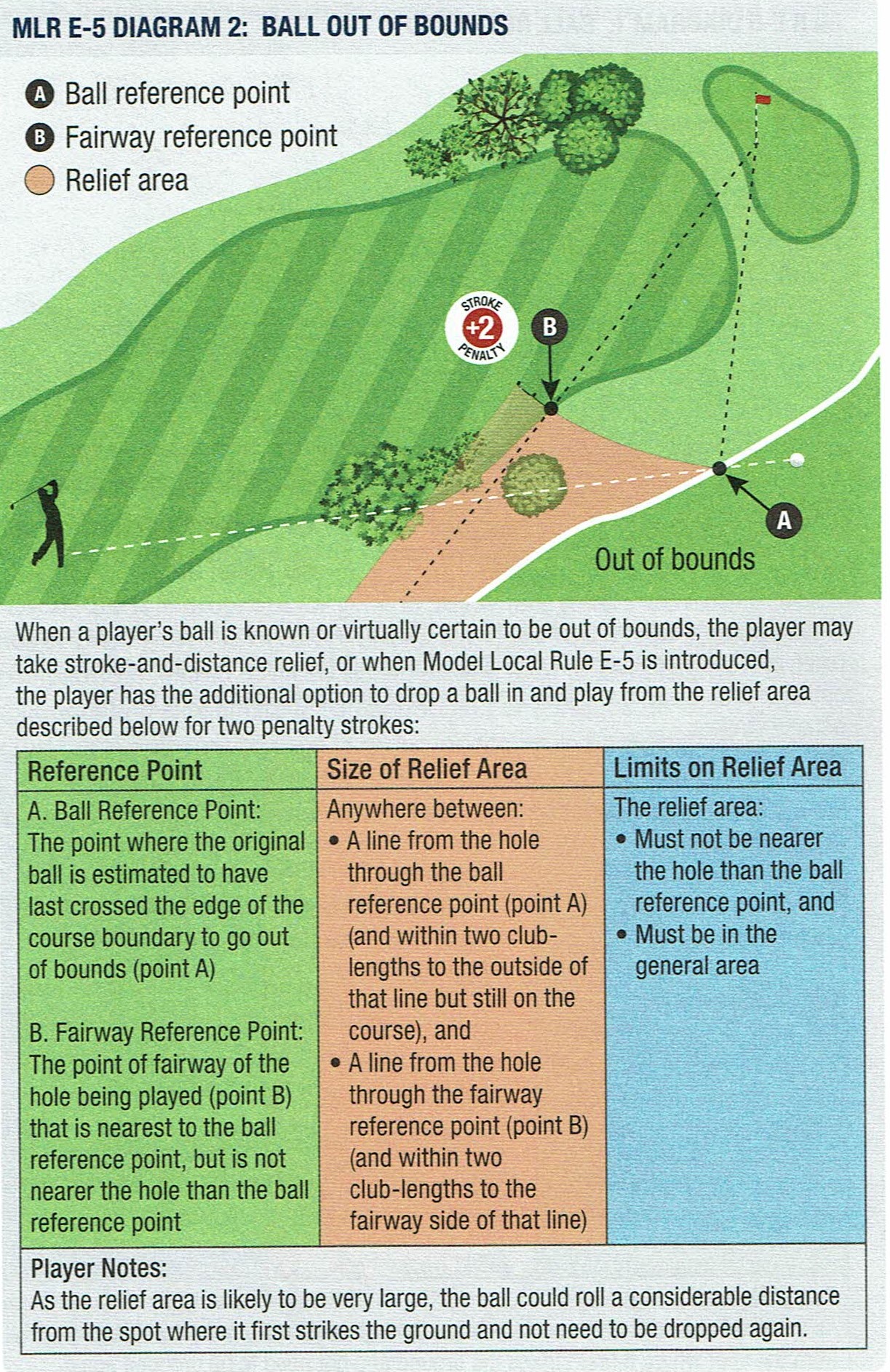
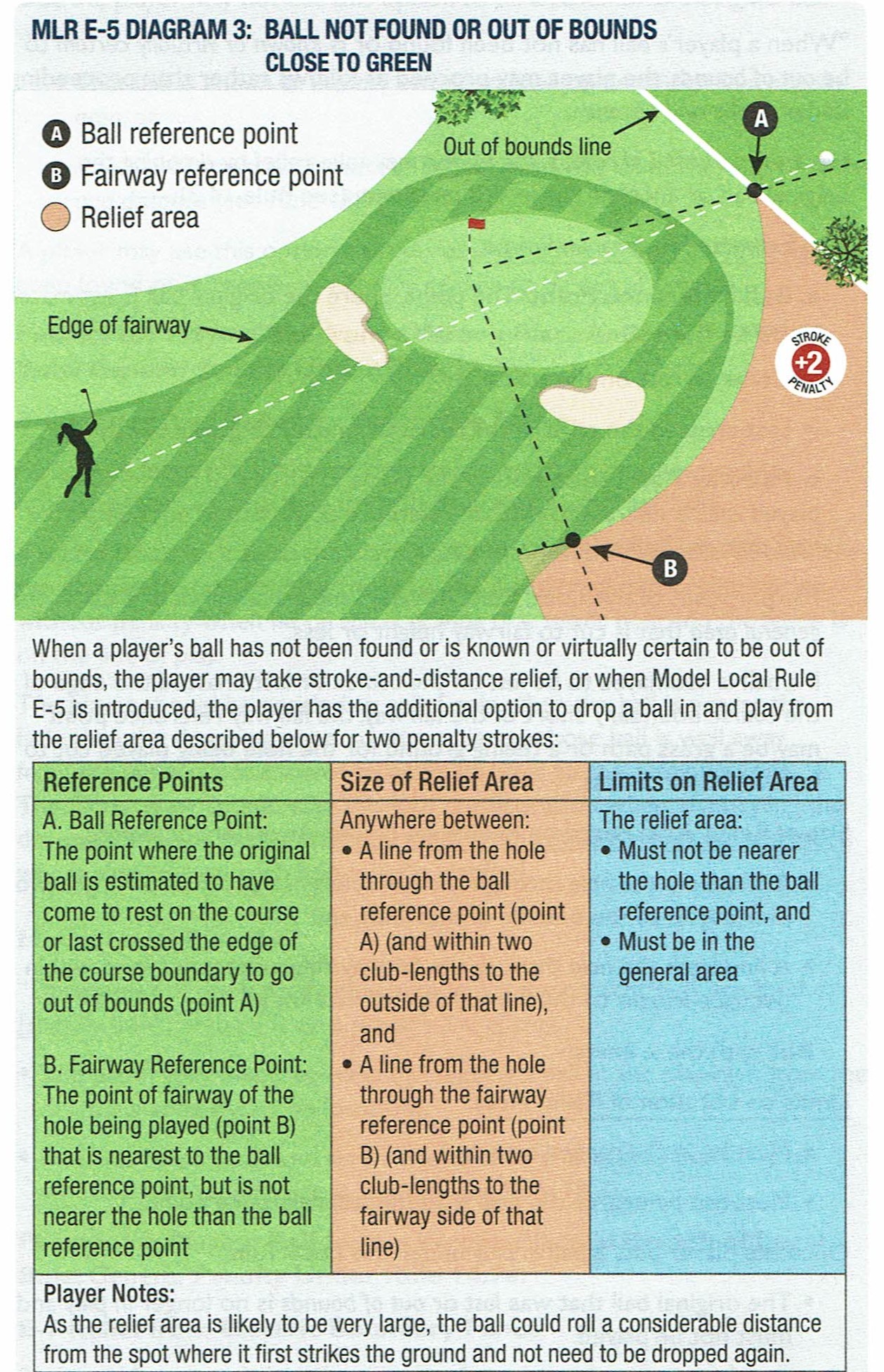
Rule
19
– Unplayable Ball
Rule
19 covers the
player’s several relief options for an unplayable ball. This
allows the player to choose which option to use – normally
with one penalty stroke – to get out of a difficult situation
anywhere on the course (except in a penalty area).
19.1 Player is only Person
who May Decide to Take Unplayable Ball Relief Anywhere Except Penalty
Area
•
Unplayable ball relief is allowed anywhere on the course, except in
a penalty area.
•
If a ball is unplayable in a penalty area, the player’s only
relief option is to take penalty relief under Rule 17.
19.2
Relief Options for Unplayable Ball in General Area or on Putting Green in each case adding one penalty stroke:
• The player may
take
stroke-and-distance relief under Rule 19.2a even if the original ball
has not been found and identified.
• But to
take back-on-the-line
relief under Rule 19.2b or lateral relief under Rule 19.2c, the player
must know the spot of the original ball.
a.
Stroke-and-Distance Relief
The
player may play the original ball or another ball from where the
previous stroke was made (see Rule 14.6).
b.
Back-on-the-Line Relief
The
player may drop the original ball or another ball (see Rule 14.3) in a
relief area that is based on a reference line going straight back from
the hole through the spot of the original ball:
• Reference Point: A point on
the course chosen by the player that is on the reference line and is
farther from the hole than the spot of the original ball (with no limit
on how far back on the line):
• In
choosing this point, the player should indicate the point by using an
object (such as a tee).
• If the
player drops the ball without having chosen this point, the reference
point is treated as being the point on the line that is the same
distance from the hole as where the dropped ball first touched the
ground.
• Size of Relief Area Measured
from Reference Point: One club-length,
but with these limits:
•
Limits on Location of Relief
Area:
• Must be within one club-length of
the reference point in any direction, and
• May be
in any area of the course, but
• If more
than one area of the course is located within one club-length of the
reference point, the ball must come to rest in the relief area in the
same area of the course that the ball first touched
when dropped in the relief area.
c.
Lateral Relief
The
player may drop the original ball or another ball in this lateral
relief area (see Rule 14.3):
• Reference Point: The spot of
the original ball.
•
Size of Relief Area Measured from Reference Point: Two
club-lengths, but with these limits:
•
Limits on Location of Relief Area:
• Must not be nearer the hole than the
reference point, and
• May be in any area of the course,
but
• If more than one area of the course
is located within two
club-lengths of the reference point, the ball must come to rest in the
relief area in the same area of the course that the ball first touched
when dropped in the relief area.
Penalty for Playing Ball from a Wrong
Place in Breach of Rule 19.2:
General Penalty under Rule
14.7a.
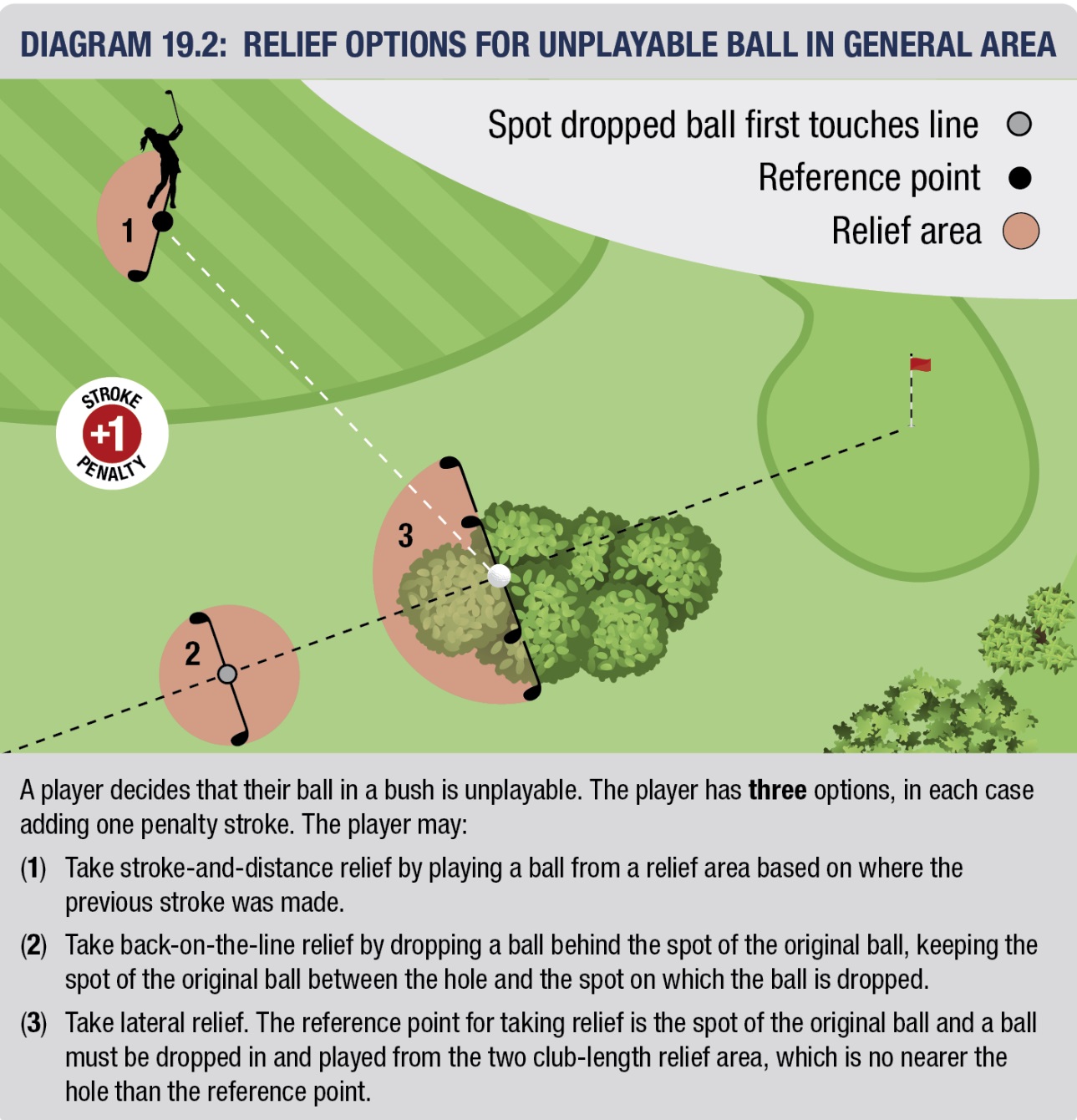
19.3
Relief Options for Unplayable Ball in Bunker
a. Normal Relief Options (One Penalty Stroke)
When a player’s ball is in a
bunker:
•
The player may take unplayable ball relief for one penalty
stroke under any of the options in Rule 19.2, except that:
• The ball must be dropped in
and come to rest in a relief
area in the bunker if the player takes either back-on-the-line relief
(see Rule 19.2b) or lateral relief (see Rule 19.2c).
As an extra relief option when a
player’s ball is in a
bunker, for a total of two
penalty strokes, the player may take
back-on-the-line relief outside the bunker under Rule
19.2b.
Penalty for Playing Ball from a Wrong Place in Breach of Rule 19.3:
General Penalty under Rule 14.7a.
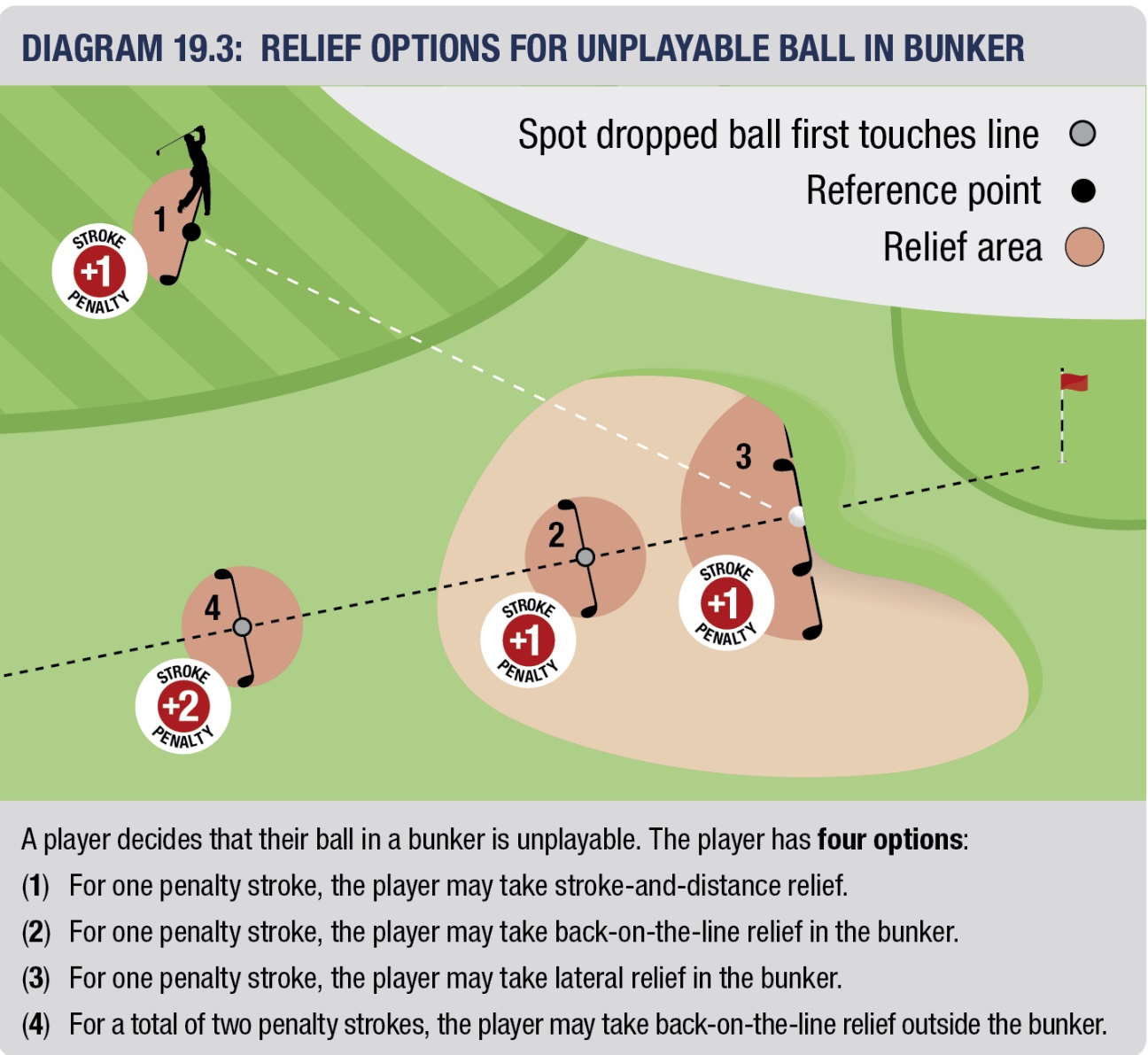
RESERVED FOR
FUTURE INFORMATION






